LAB & REVIEW: Carl Zeiss Ultron 1,8/50 (1968-1972)
“LEGENDS. REALIZED.”
I seldom test vintage lenses. But this one, the Ultron 1,8/50, has attracted my attention enough to yield this article.
People said, it is the sharpest, finest-resolving standard lens of all. People said, it boasted qualities and characters that had been lost in modern lenses. People said, it is the father of all high-definition modern standard lenses.
People said it’s that good. I find that questionable.
Here, we’ll be finding out soon how good a fifty-year-old piece of glass can be.
Design Analysis
The Ultron 1,8/50 is designed by Albrecht W. Tonnier, Joachim Eggert, Fritz Uberhagen, with the respected patent published in 1971. The design can be found under the US patent number US3612663A.
It was produced from 1968 to 1972, a few thousand units were produced.
At its core, it still used a Planar-like design, with symmetrical arrangement of two negative and four positive elements around the aperture. The most prominent addition to the Planar formula is the concave front.
It should be noted that the Ultron is the first lens that utilized computational optical design under the Zeiss name.
Traditional Planar designs using six or seven elements in a symmetrical arrangement has the problem of peripheral rays only see a very shallow, edged part of the assembly. Passing through much less refractive surfaces, they stay heavily undercorrected compared to the center. Most notably, since the refractive surfaces are not concentric to the optical center, this can cause strong deviation of the different phases within a beam of light, leaving sagittal focus apart from the meridional focus, or otherwise known as astigmatism.
The Ultron sought to mitigate this problem by forcing peripheral rays to the center of the dioptric rear lenses by extending the chief ray path and expanding the paraxial rays, using a special aplanatic element in the front, marked L1 in the patent figures. This way, the rear assembly can be largely reused for the peripheral rays and the axial rays alike, making more delicate corrections of the edges are possible. As states in the patent, after the L1 lens is added, the following lens can receive as much as 61.7% greater dioptric rays than designs without, thus increasing the manipulability of the later elements.
The L1 element has two concave surfaces running perfectly parallel, and thus having zero dioptric power. No aberrations were introduced since it has no dioptric power, thus it would not add extra pressure for the rear parts. The curvature was said to have been tweaked by the computer.
Similar purposed aplanatic lenses, or really any aplanatic lenses at all are seldom found in photographic objectives. Only Canon has used a few of those in their superteles. The most common place aplanats can be found, is actually microscopes. Optical microscopes often used a number of aplanats at the very front to reduce receiving angles for the following optics, and thus improving aberration correction environment. Though microscopes often used semispheres and Cartesian ellipsoids to achieve a better effect, in a broad sense, their purposes are very similar to the one found on the Ultron.
Furthermore, the two dispersive elements surrounding the aperture, it was said, to have their position and refractive power tweaked to reduce lateral coma without losing the anastigmat properties. Further tweaks of the rear also served to increase tolerances to imperfections of L1, as perfectly parallel optical surfaces are very difficult to manufacture.
The entire lens assembly moves outwards when focusing. Not internal or floating mechanisms are employed. A common practice for its time.
The glasses used in the lens are fairly loaded for the time it was designed. The L1 element is crafted out of Schott Leaded dense crown K10, and the following lens contained LaK14 and SSK8, both very dense, high-refractive (at the time) crown glasses. These crowns are perfected with SF10, Lead-containing heavy flint, the material of the fourth element; and LaF2 heavy Lanthanide flint, used to make the last element.
But, despite using some of the newer and advanced materials for its time, the width of the selections in this lens are very narrow. Tonnier said exquisite corrections of chromatic aberrations were employed to further enhance resolution, but I personally held that questionable. It seems, the choices to higher refractive indices was prioritized over dispersion properties. The Abbe numbers of these glass types differ only very marginally, most sat around a 50-60 range, with the only exception of SF10, having an Abbe at 28. By modern standards, of course, their abnormal dispersive powers are just poor, leaving a high chance in undercorrected secondary spectrum. In the following tests, we are going to see some quite visible amount of chromatic aberrations.
Furthermore, the use of LaF2 and SSK8, both performed poorly in spectral transmissions. Materials with higher refractive indices are useful in controlling higher order residual aberrations, since they would require less surface curvature to reach the same dioptric power. However, that comes at a cost. Both glasses’ internal transmission dropped below 90% for wavelengths of 400nm and shorter (per 10mm thickness). SF10 was the worst, dropping to a mere 36% transmission at the 380nm wavelength (per 10mm thickness). That is certainly enough to affect color reproduction.
Now, for the saying that this design has spawned all modern high-resolution standard primes – not so much.
Many flagship modern primes, like Apo-Distagon T* Otus 55mm f/1.4, Signature Prime 58mm T1.8, Supreme Prime 65mm T1.5, Planar T* FE 50mm F1.4 ZA and Lumix S-Pro 50mm F1.4, all went the exact other way of manipulating light rays. They intentionally let peripheral rays arrive further apart from the axial ray, to use different part of the same piece of glass to different purposes, allowing far more delicate control. On larger lenses of the collection, like the Otus or the Signature Prime, it can be easily seen that every micron of glass, and every single group of optics are assigned of different purposes. Each group tends to fix one or two specific type of aberrations, as only highly specialized components can deliver the optimal performance. That is true across the whole industrial world, not just optics.
We can certainly call the Ultron a clever design. It is. It used only very minimal addition to the traditional Planar mix, and obtained some performance (at least in terms of resolution) not surpassed in some fifteen, twenty years or so.
But, understanding the law that specialization taxes on the design budget heavily, we will soon see where the Ultron falls short by going all-in into resolving power only with a meager 7-element design.
This particular review was not affiliated with Zeiss or any distributors of the Ultron 1,8/50. Only one copy of the lens was tested.
(I wondered if the marketing or the PR department of Zeiss would care at all about this lens right now. Probably not.)
All sample images in this review were only tweaked in exposure, white balances, as well as cropping. No sharpening or other filters were applied.
If something looks like a 100% crop, then it probably is.
Exterior and Handling

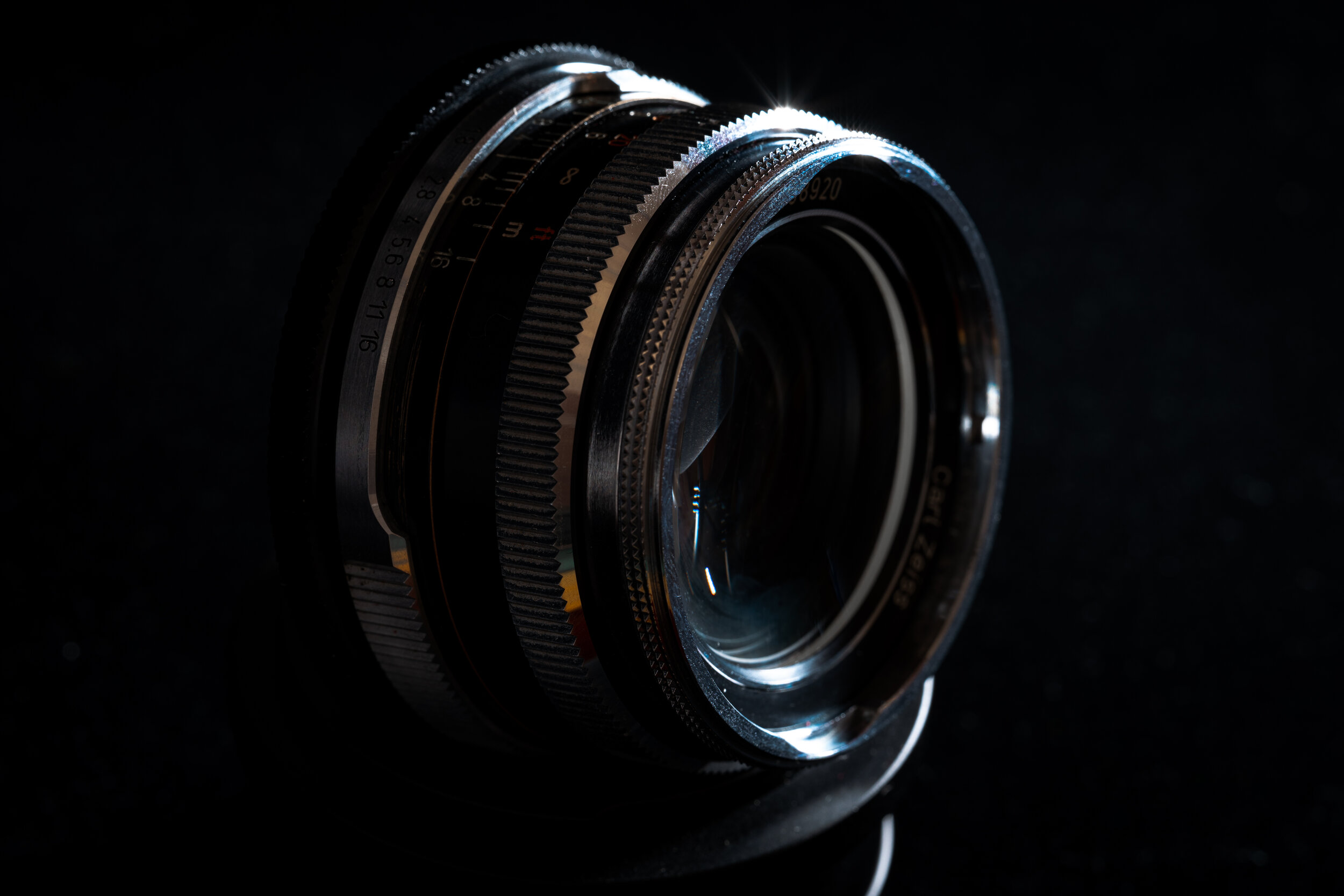
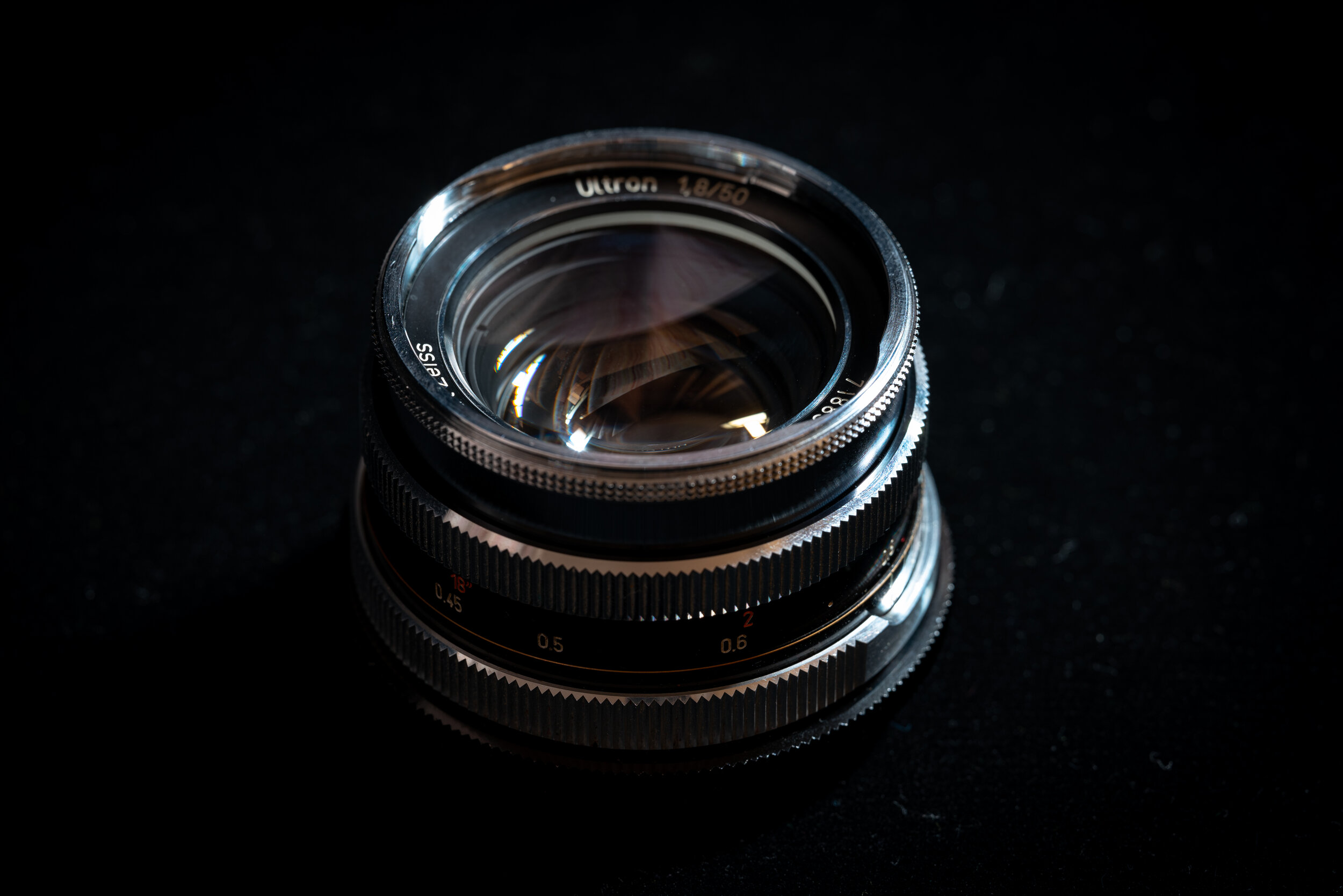
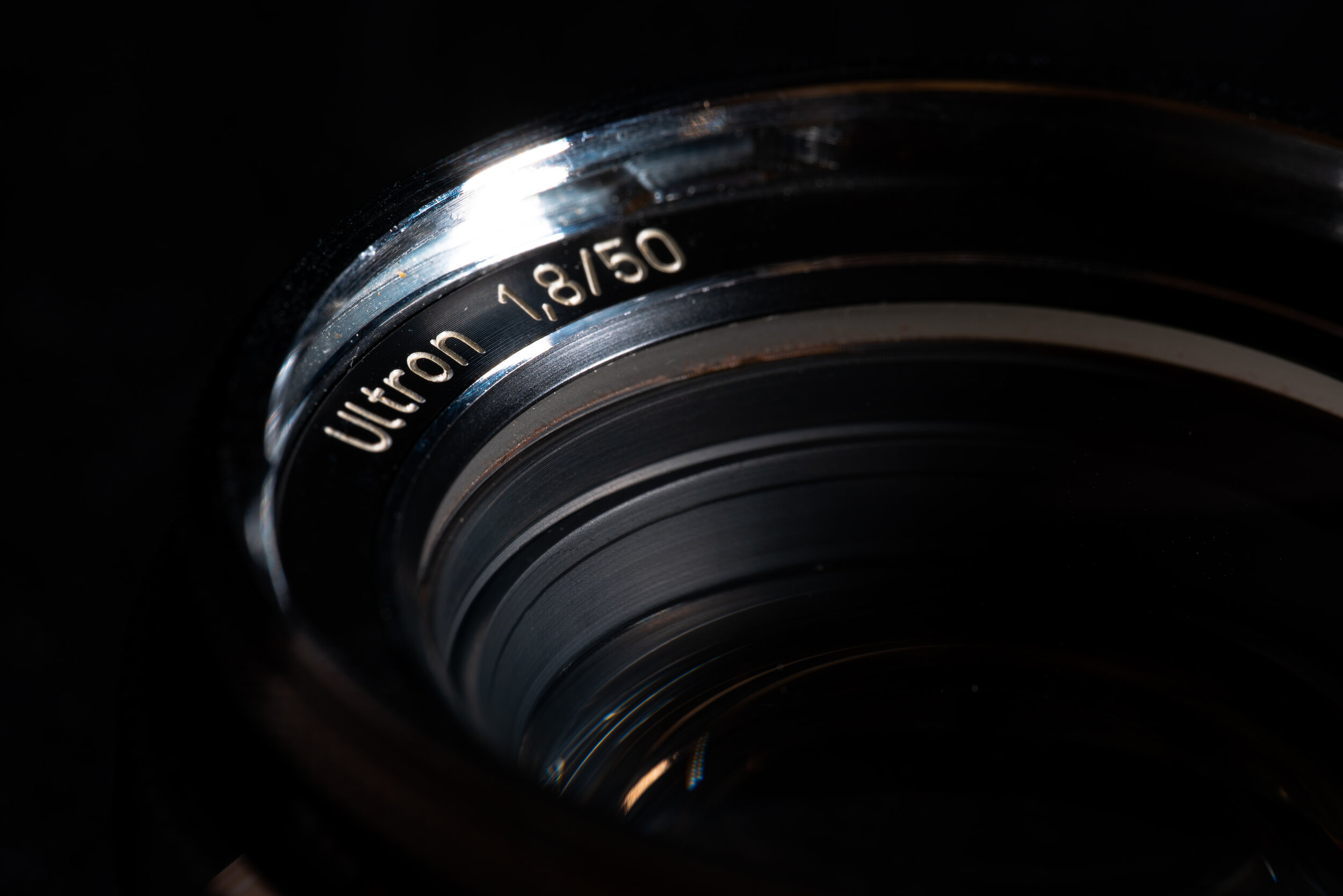
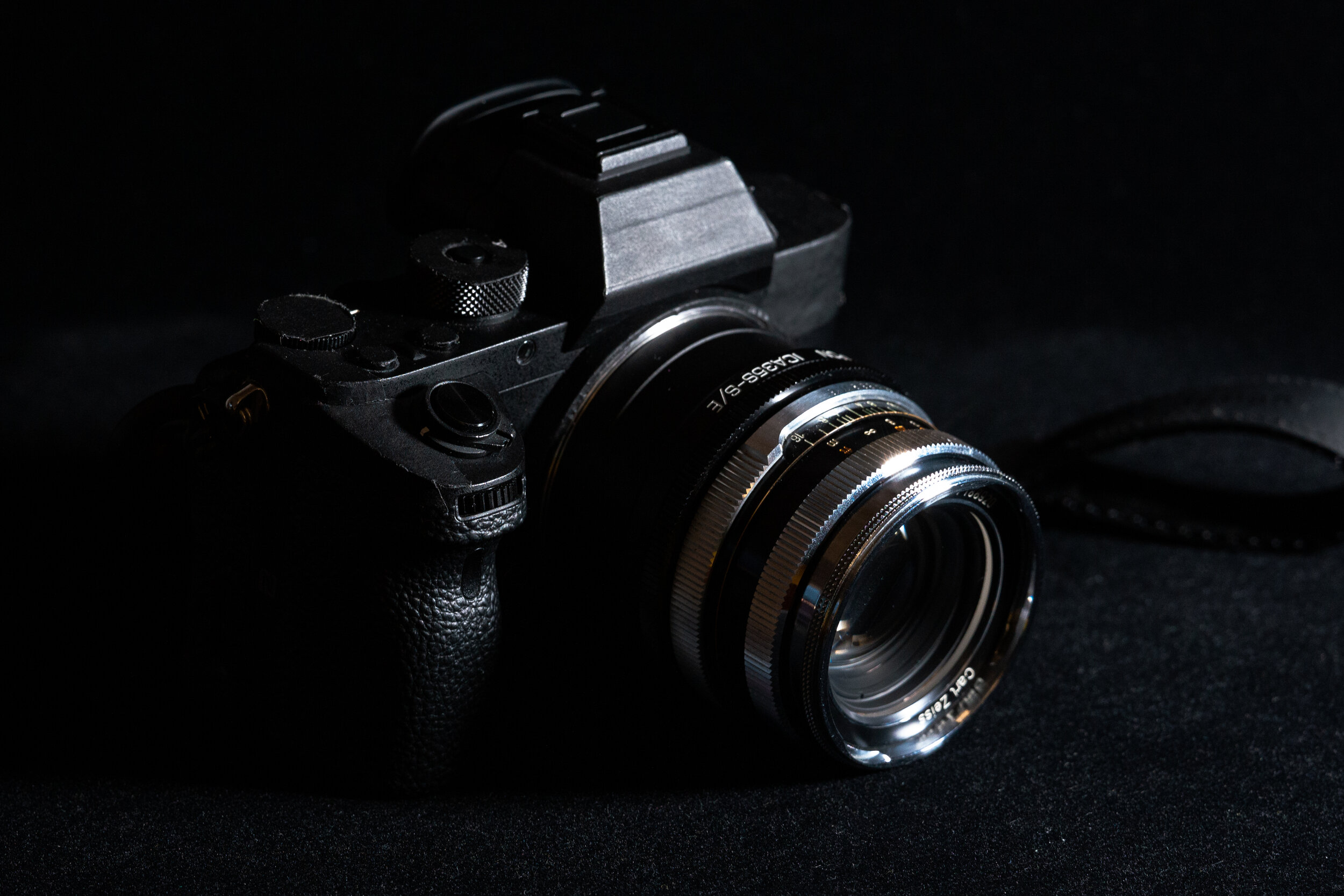
This is a tiny but highly dense little lens. I believe the skeleton and shell are both copper, casted or milled. It is quite a substantial object to hold in hand.
The exterior is interlaced with chromed metal and black paint. All markings are engraved and filled with paint. That’s the 60’s aesthetics we are talking about. Whether not you think it looks good is a completely subjective thing, but I call that nice build quality.
From the fact that many, including the copy I came across, has endured fifty years of abuse, I would be comfortable saying this is a very well built lens. I believe the system did offer rectangular hoods, but my copy did not come with one, thus I am unable to provide any opinion on that subject. It did not have any engraved filter thread either, native use of UV/protective filters are impossible. Any 0.75-thread filter has to be adapted. Bummer.
Handling wasn’t bad, but certainly not a pleasure. The front decorative ring has a very similar texture to the focus ring. I cannot recall how many times I’ve grabbed onto that decorative ring trying to focus, only to find out that it does not turn. Aperture stops are not clicked, and are not equidistant from each other. Combined with the obvious lack of electrical contacts, it required visual checking of the readings every time the aperture is changed. This means you have to put down the camera for accurate adjustments, and I have found that to be a constant interruption to my flow, an annoyance, even. Yes, I am aware that lenses from that age are like that. It’s not necessarily the Ultron’s “fault”, but it’s a thing. Face it.
Otherwise it’s still nice to touch. The resistance of both rings are reasonable to my taste, and their knurled grooves are indeed proofs of quality. The focus ring turns for some 120° or so, and the aperture rings turns for about 45°. I consider the travel to be reasonable.
It balances well when adapted to a Sony Alpha body, and certainly feels even nicer on its original Contarex system.
Coatings appeared to be pale yellow to completely clear.
Resolution
MTF & Lab Results
The lenses are tested against an Imatest SFRplus 5×7 chart at a distance of approximately 5m.
Each aperture setting is sampled at 0mm, 4mm, 8mm, 12mm, 18mm and 22mm from the geometrical image center. A total of four rotations are tested, and each point are sampled twice times before the values are averaged. It is usually considered the 10mm circle is the “midframe”, and is also where the rule-of-thirds points reside. Image field beyond 16mm is significantly cut-off by the long edge of the sensor, and is of less importance for that reason.
It is usually recognized that the 50% modulation is most recognized by the human eye, and the 30% modulation is the lower limit identifiable by a sensor, digital or film.
Samples are tested with a 42.4MP IMX251 sensor, with Nyquist Frequency at 110lp/mm. Thus, only frequencies up to 120lp/mm are tested. Higher or lower resolution sensors would likely see somewhat different numbers, but not dramatically, especially at lower to mid frequencies.
Debayer processing was done using dcraw. All sharpening, embedded profiles, etc., are bypassed. (The Ultron did not have one anyways)
I usually judge lenses with respect to optical perfection. I’ll try to give the Ultron some leeway for its age.
Since the Ultron is adapted, it may perform differently on film or sensors with different coverglass thicknesses. I have found my test results to be reasonably close to simulation results from the patent data, I do not consider this particular case to be a worry.
Please not the color coding of the lines at f/4.0 and f/5.6 are different than the rest.
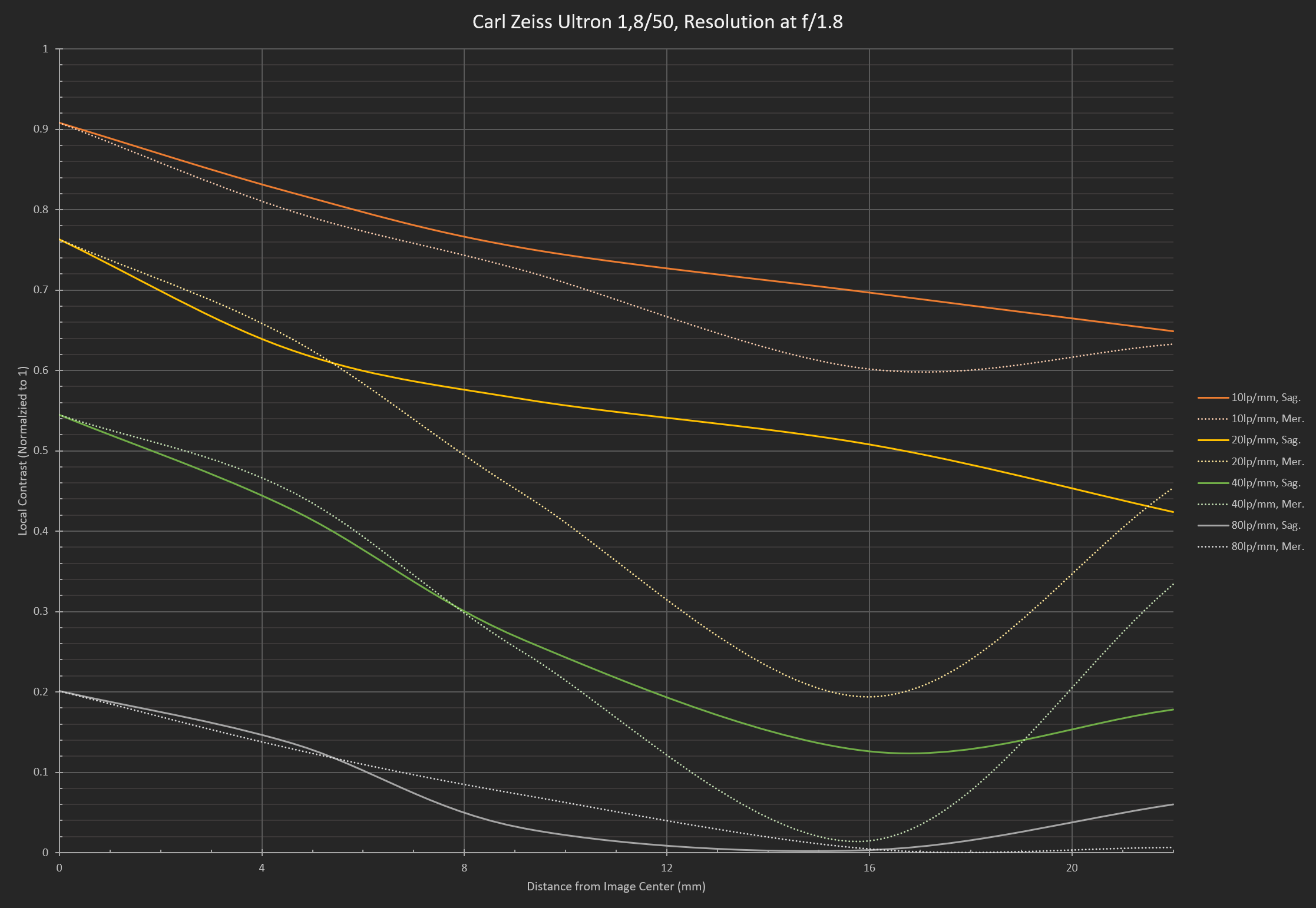
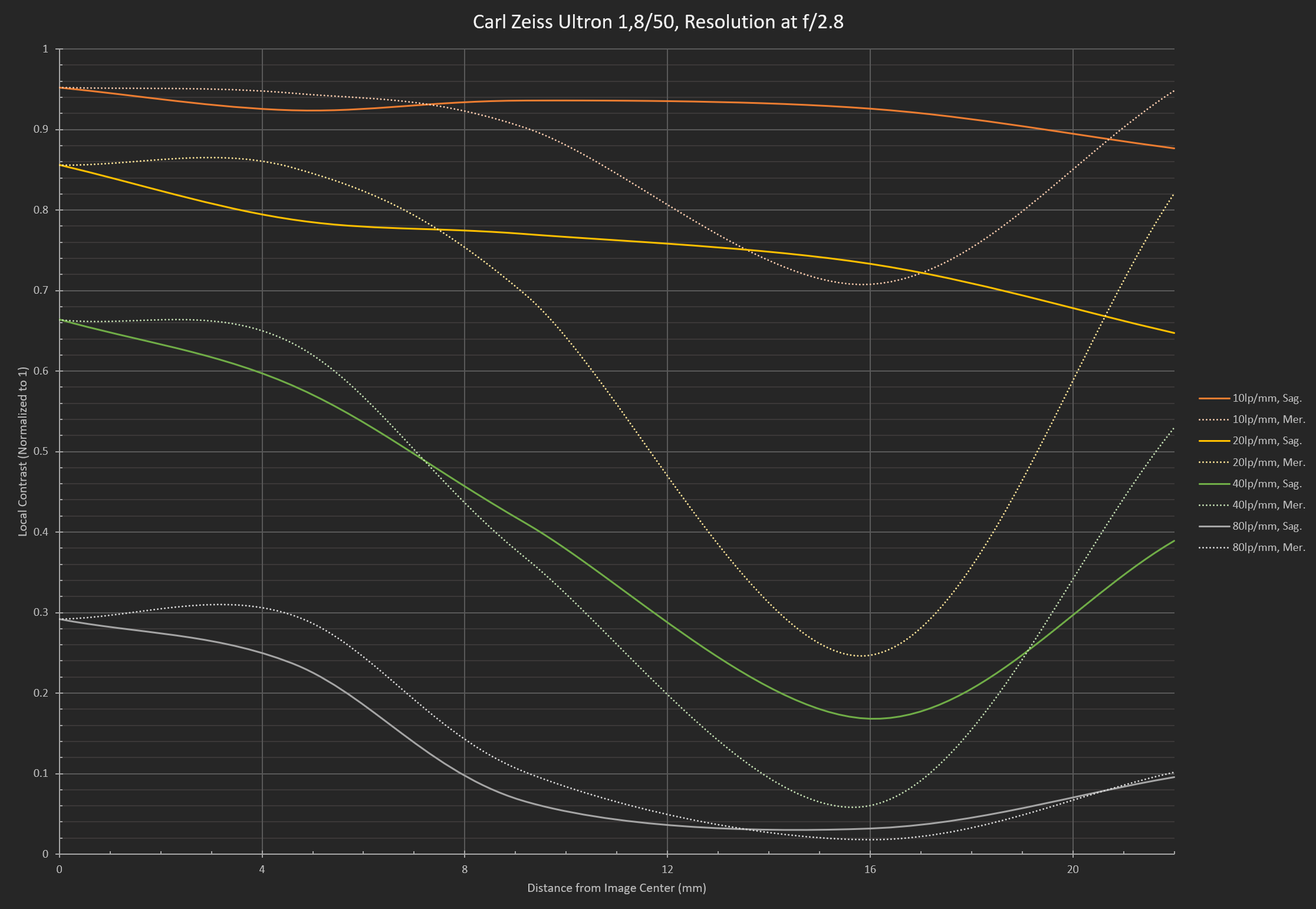

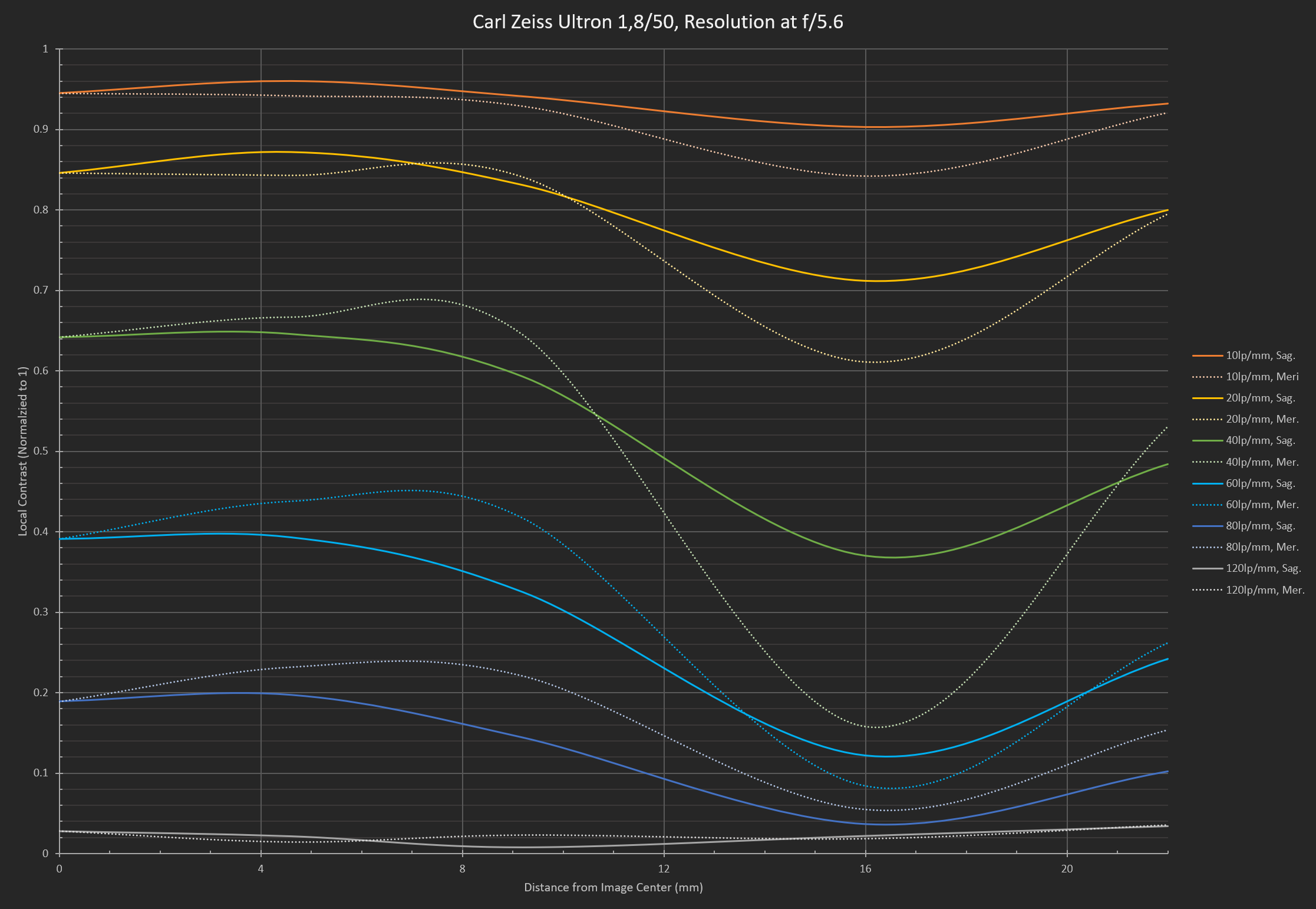
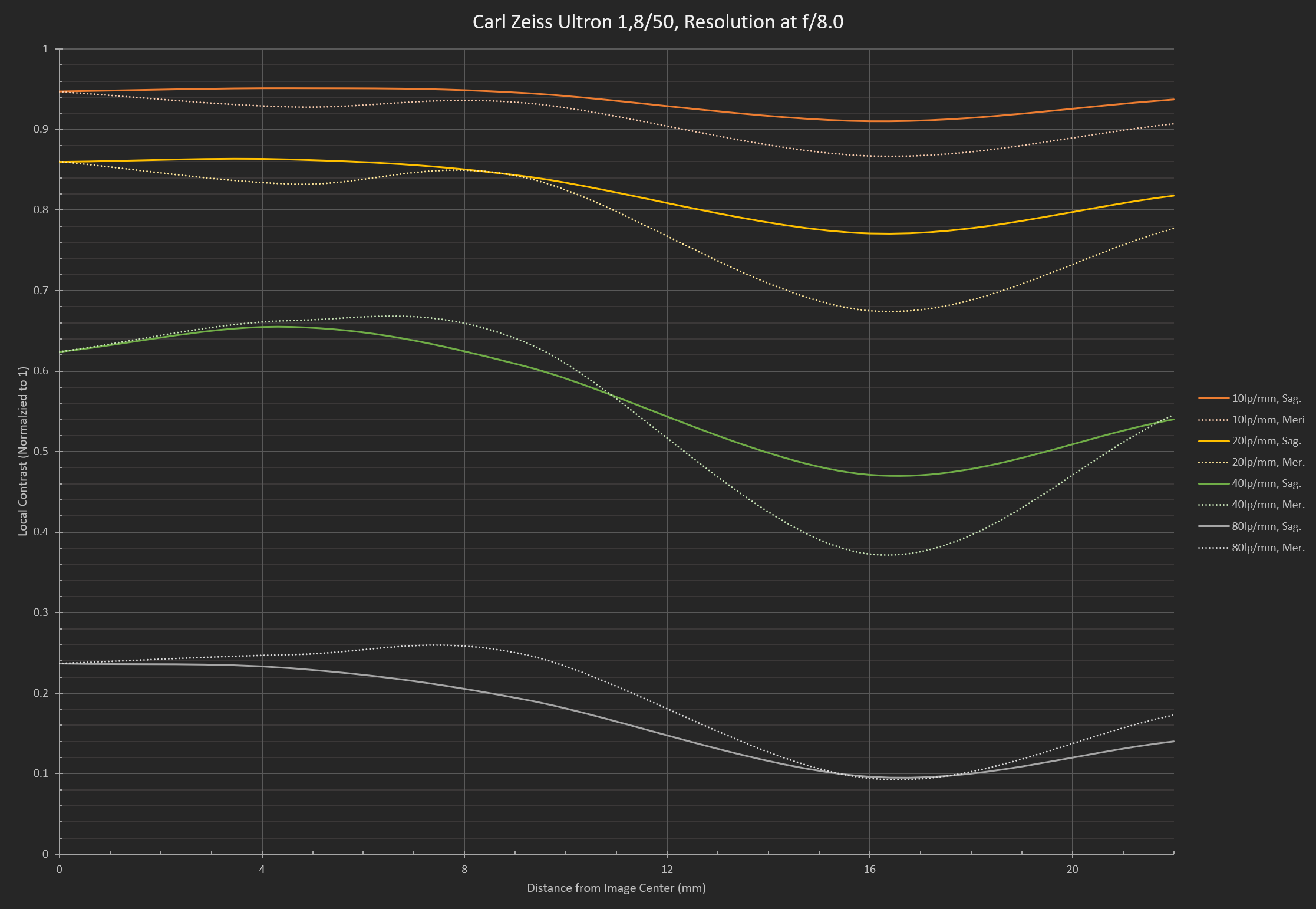
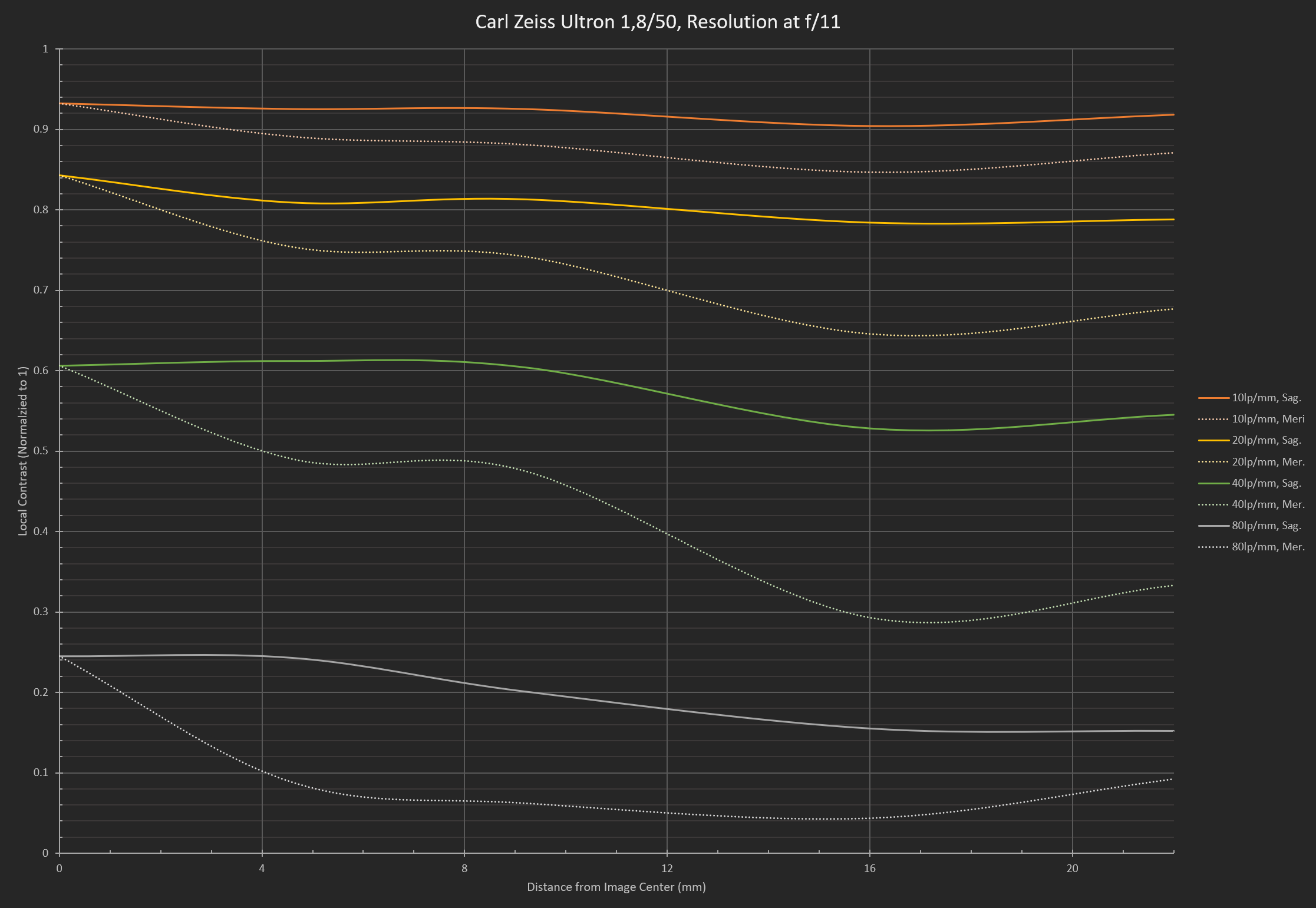
Wide-open contrast is very-low, with coma visible even in daylight.
Wide-open resolution was… low. That was due to uncontrolled lower order spherical aberrations flooding everywhere. Coma further infected the edges of the image, giving the outer part a smeary look we’ll soon see in the later part.
I understand this is the “vintage” character people are looking for. Here’s the thing, for a high-contrast image, there are thousands of ways you can make it low-contrast, dreamy, blurry in post; while for a natively low-contrast image, there are few things you can do. Factual. Deconvolution is always harder than convolution, not mentioning there are cases where the kernel cannot be isolated, making the computation near impossible.
When wide open, even focusing was a problem. The contrast is so low, I found it difficult to determine where the focal plane is, as the focus peaking was completely unresponsive at that level. In this case, splitted-diopter focus screens on SLRs may actually give better experiences than that on mirrorlesses, due to the longer detection baseline.
f/2.8 improves contrast and resolution drastically. The Ultron has became fully usable at this point. 80lp/mm was finally boosted to 30% modulation at the center, the limit where differences can be visually identified. However it didn’t hold for long as we go down the imaging field, the 30% modulation line quickly deteriorated below 40lp/mm right at midfield and never recovered.
f/4.0 seemed to be the optimal aperture across the frame. Contrast is excellent across the frame. Resolution peaked at around 70lp/mm (3400lw/ph) at MTF50, and some 90lp/mm (4300lw/ph) or so at MTF30. 120lp/mm line got a boost, but it never reached the 30% threshold. The midframe sag, caused by severe field curvature, was further emphasized as well. The edges also improved with the reduction of coma and lower order SA.
Looking at the center, this is truly an accomplishment. Not every modern lenses can resolve beyond 100lp/mm, even at center.
f/5.6 improved the edges some more, especially the midframe field curvature was compensated by increased depth of field. However the center fell off quickly due to diffraction, almost halved the resolution you get at f/4.0. The 120lp/mm line completely dies across the frame, with the 80lp/mm struggling to hit 30% modulation but failing to do so everywhere.
At f/8.0 and f/11, things started to get uninteresting. Higher frequencies fade away, and midframe continued to improve slowly.
Given the fact that the field curvature is so strong, I focused the Ultron locally at each sample point to create a simulated curvature-free MTF, on the right half of the above image.
Please be advised that this is only theoretical performance. In practice, it is extremely rare, if at all, one will get to do a focus stack across the frame, like what the macro people do. In other words, this performance does not occur in real life.
My copy of the Ultron is slightly tilted. The true optical center is not at the geometrical image center, resulting the bulge of contrast at around 3mm after data was combined.
After the curvature was compensated, the resolution was respectable. Midframe sharpness levelled out, though the far edges still did not improve much. In this sense, the anastigmat performance Tonnier had called for was readily in place. Resolution anisotropy was very low, even with chromatic aberration taken into account.
At lease if your subject is off the center, you can comfortably focus the Ultron on it without losing local resolution.
So, in response to a popular claim, is it the sharpest standard prime?
The short answer is no.
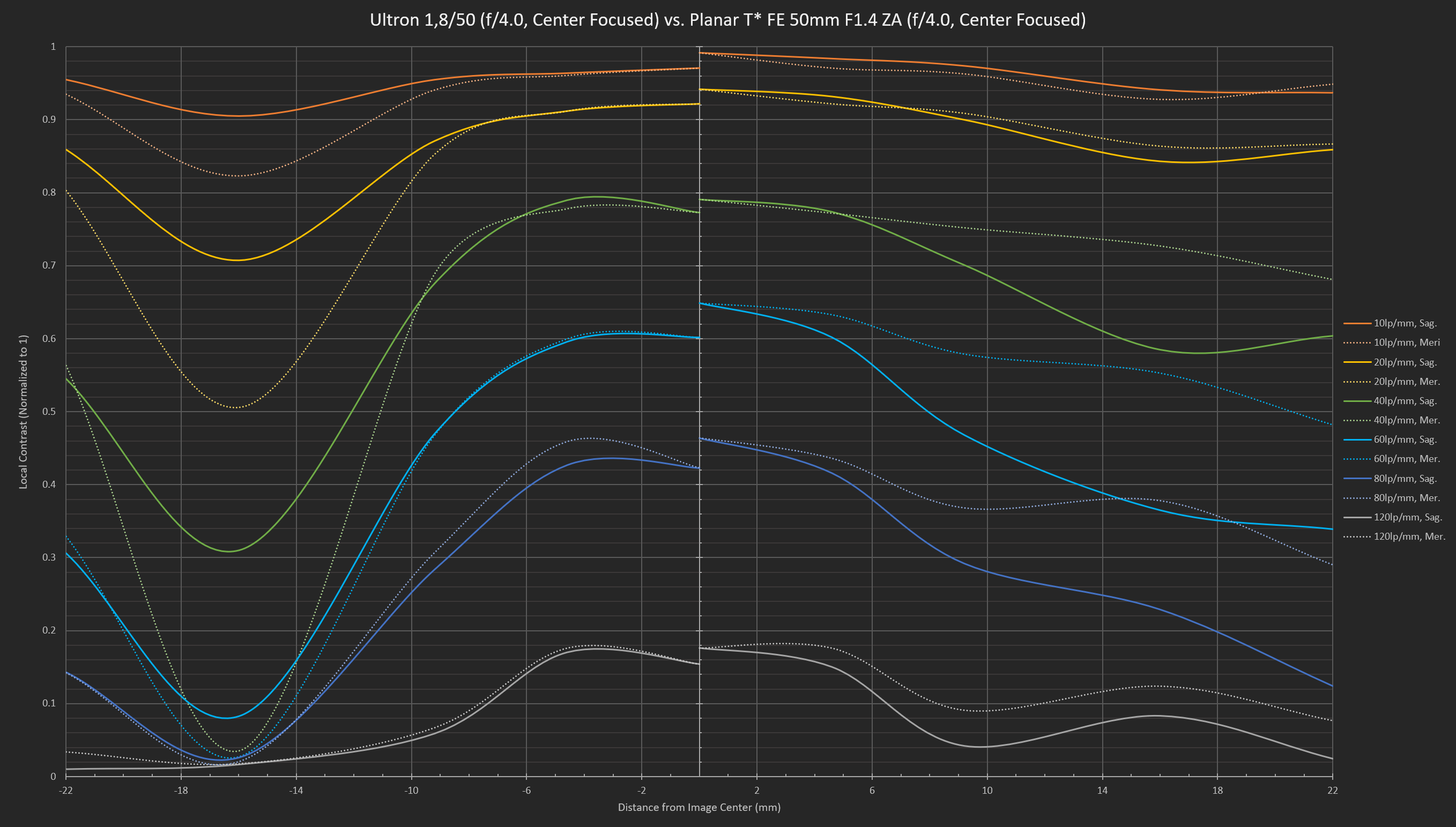
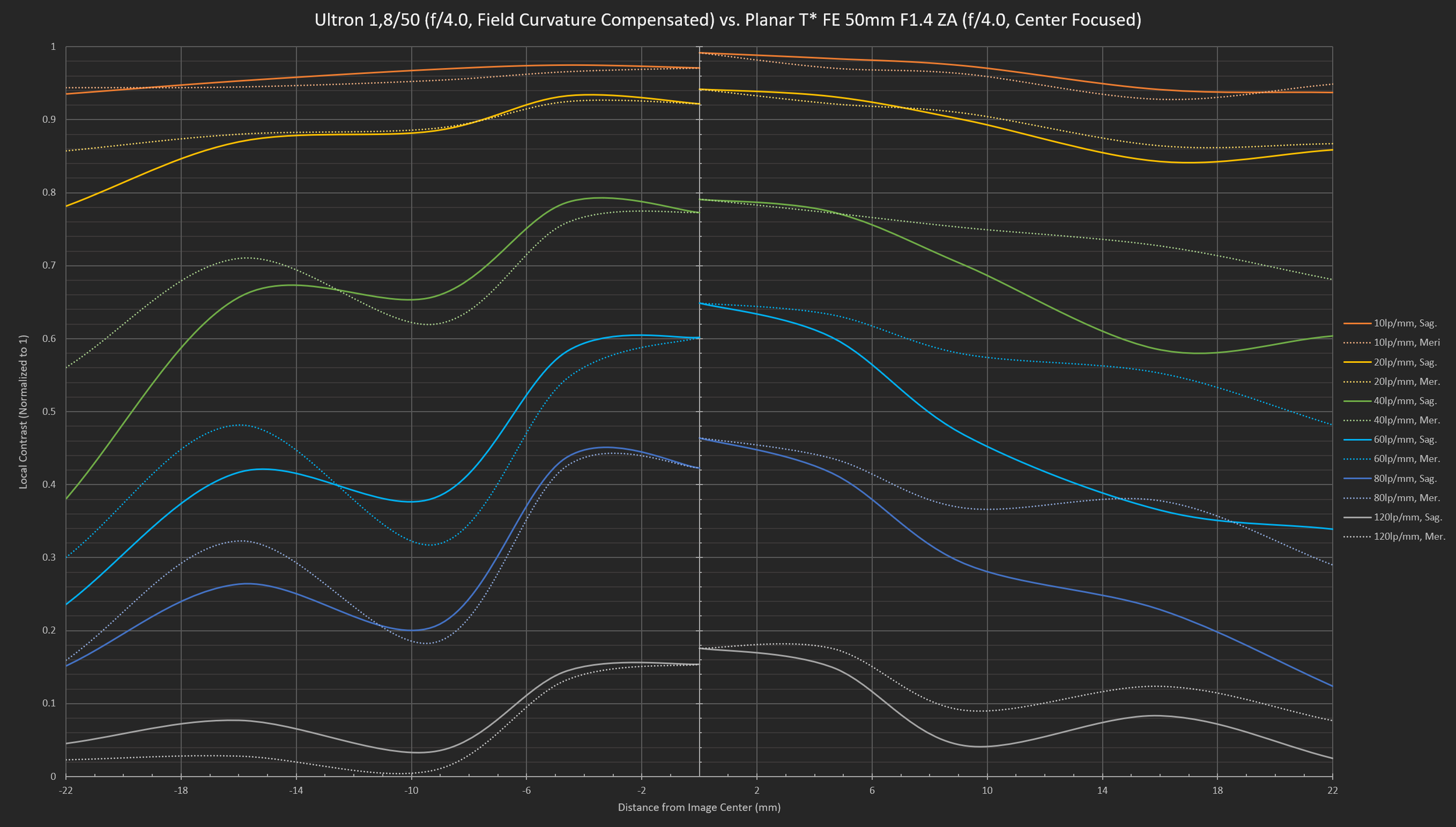
It was crushed, with great ease, by a modern construction like the Sony Planar T* FE 50mm F1.4 ZA. I didn’t even have to use installations like the Otus to make this point.
The ZA’s extremely flat imaging field annihilated the Ultron without moving a finger. Even when compared to the compensated profile, the ZA excelled at every single sample point. It showed a minor amount of astigmatism in the far field, but the performance is still superior with that taken into account. That’s some truly stellar scores put up by the ZA.
Mind you, in this test Ultron had the leeway of running the test on its home turf. The ZA’s optimal aperture was f/2.8, and it is a native f/1.4 lens, meaning that it has to combat a far greater amount of aberrations to start with; and it has already lost some high frequencies due to diffraction.
It is an unfair comparison, I know. But please, stop spreading things like that.
From a subjective standpoint, both lenses performed spectacularly in the test. The fact the Ultron, being a fifty-year-old design, can put up a fight at all is very respectable. It actually came very close to the ZA at the far frame, at around 16mm or so on the compensated profile. Again, respectable performance.
Real-World Performance
Generally, in use, this lens performs well at far distances, stopped down. Fine lines are resolved with pleasing fidelity and reasonable contrast. This is coherent with the above MTF results.
At portrait distances, it softens up visibly at larger apertures. The lady’s hair and the purple umbrella in the second set lacked both contrast and definition. The case is the same with the picture of surveillance cameras.






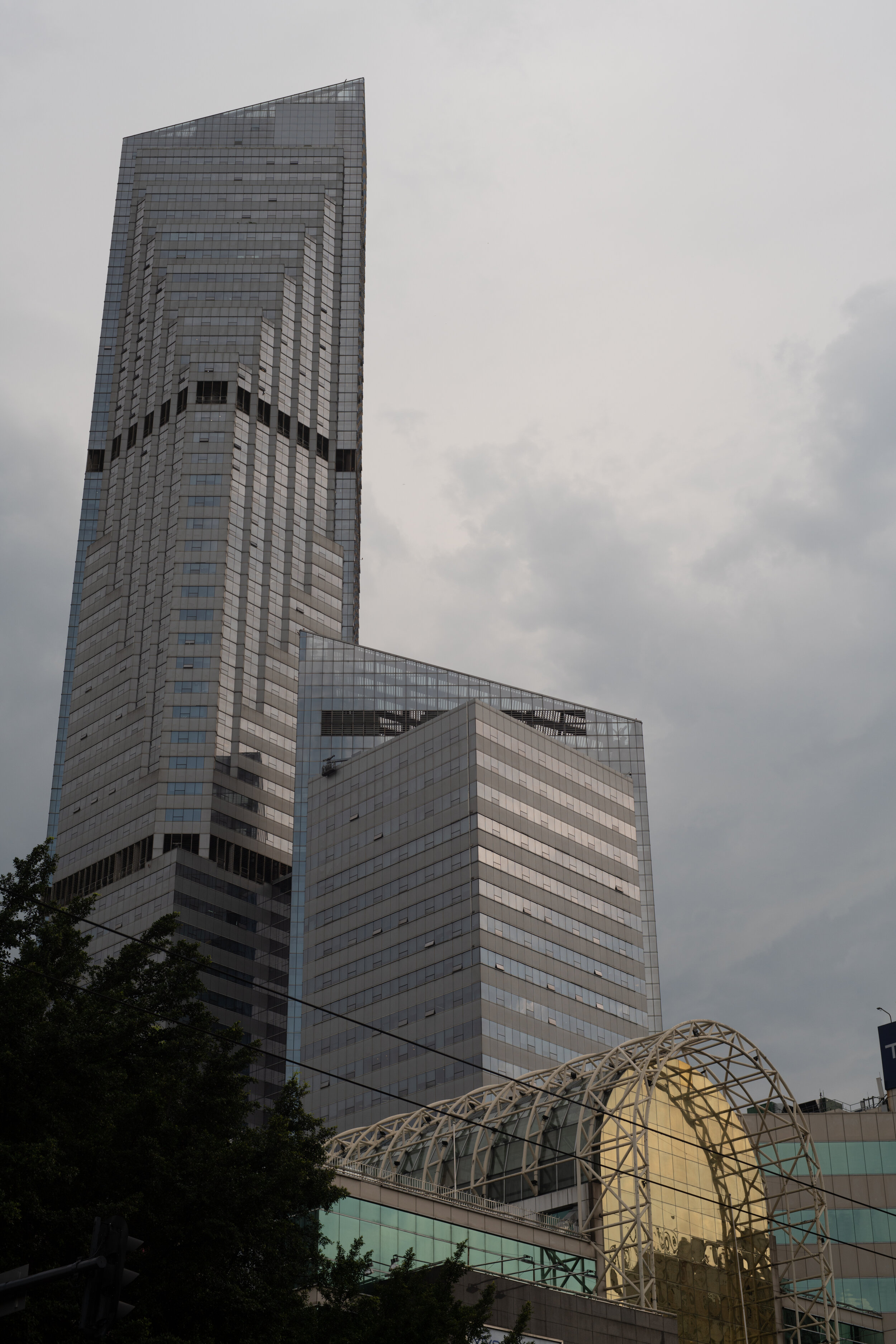
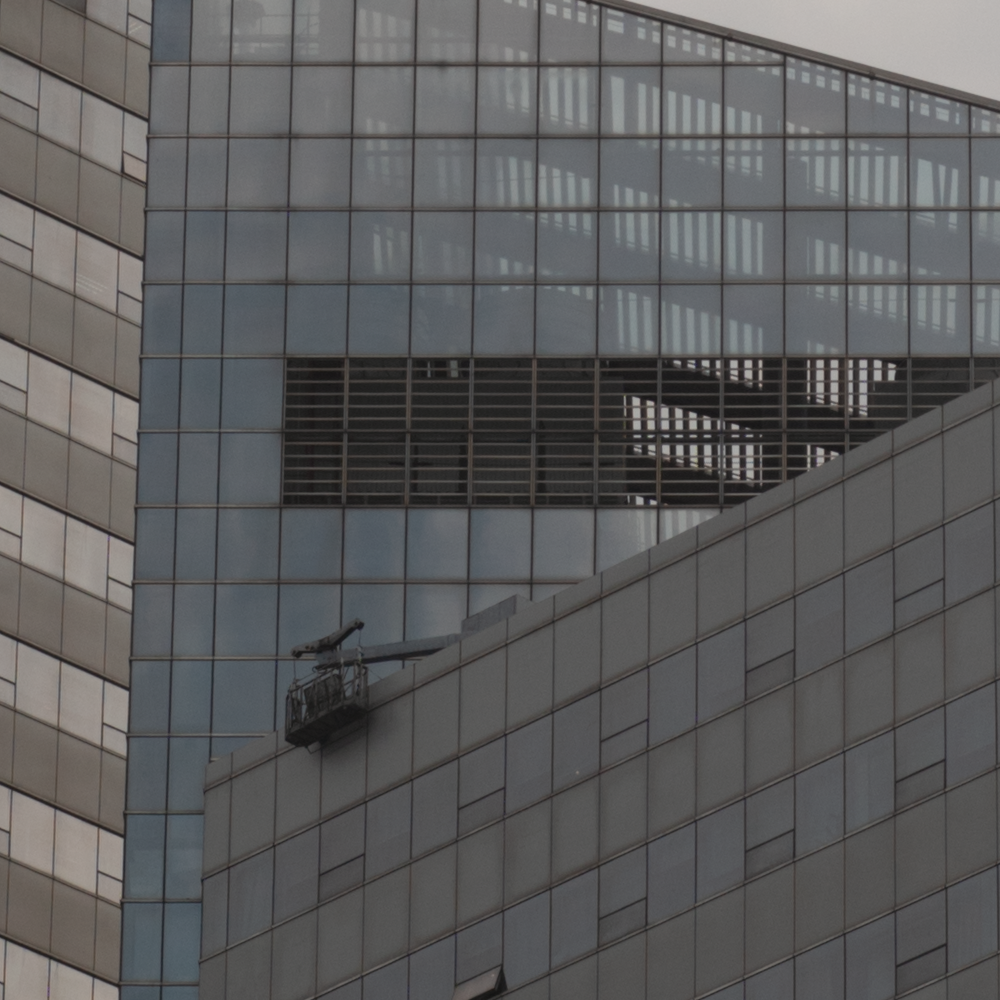
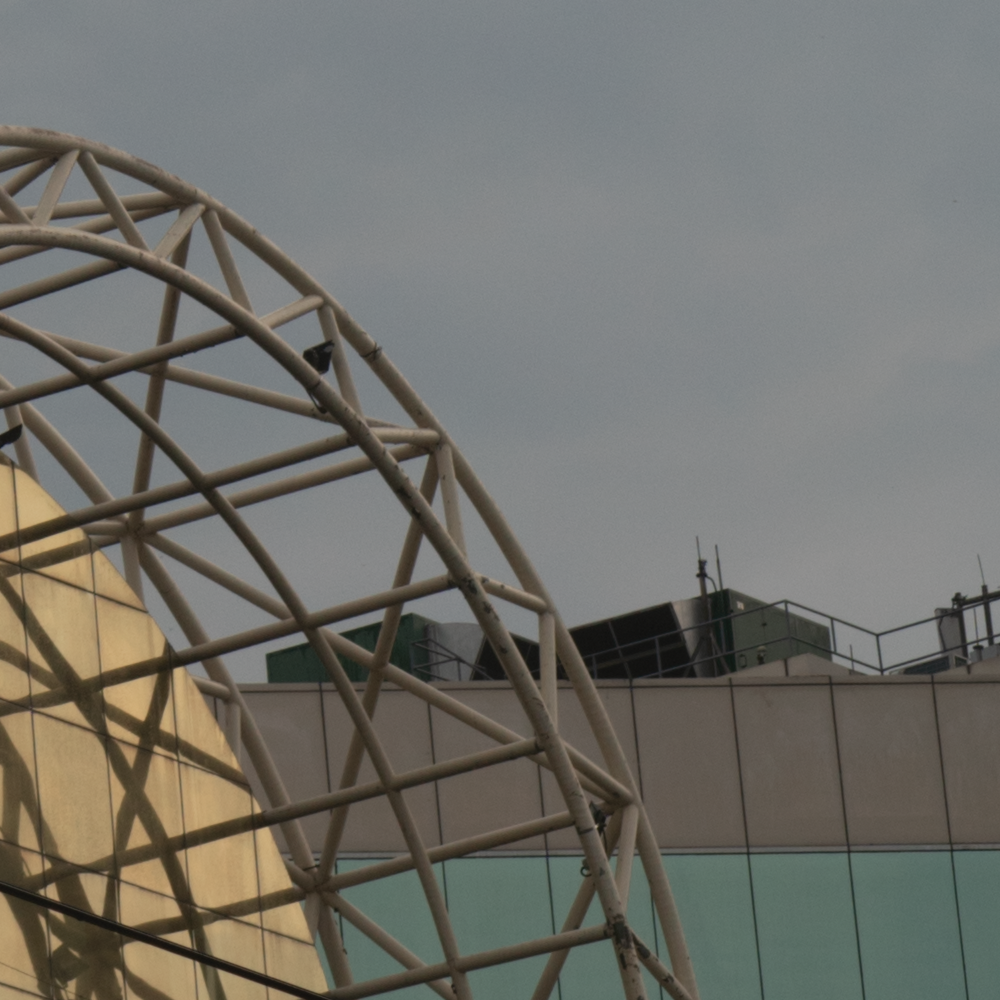
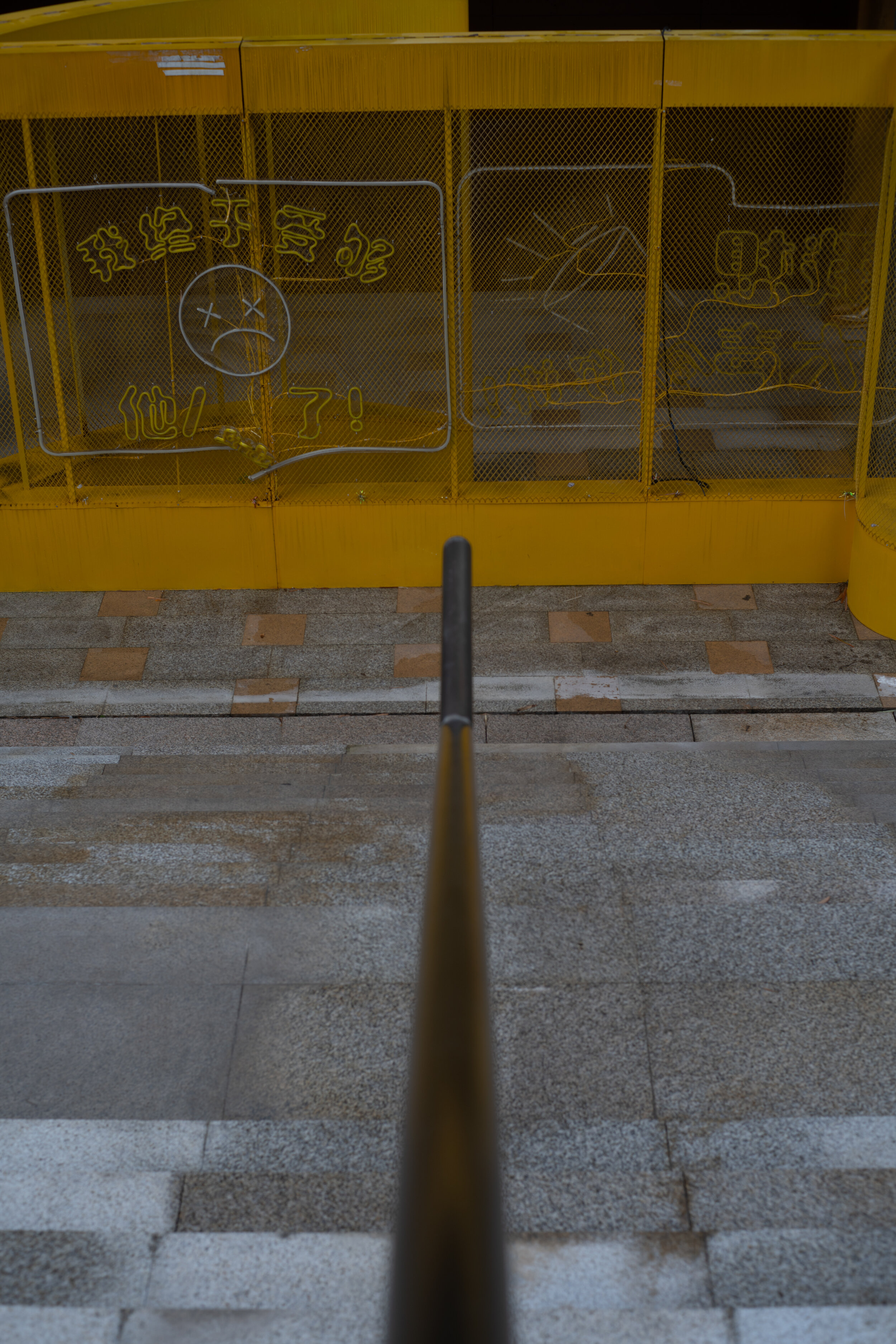
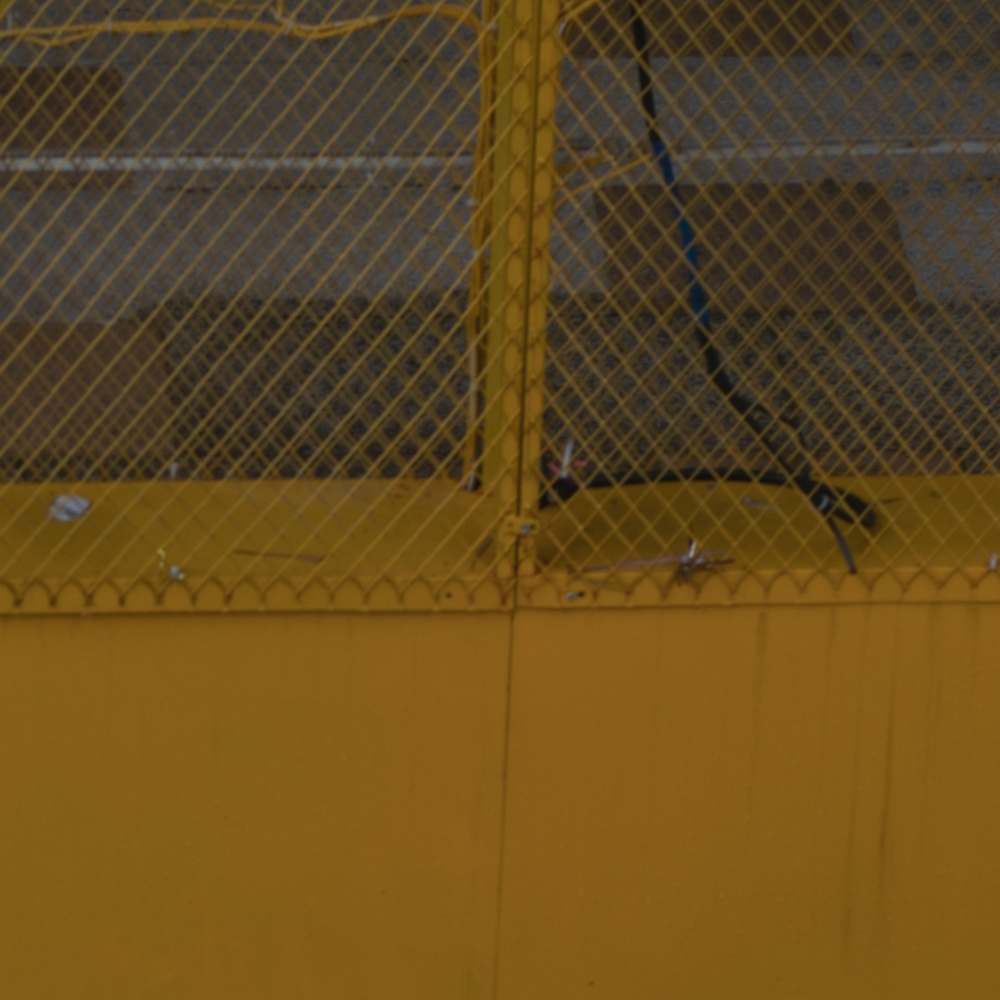
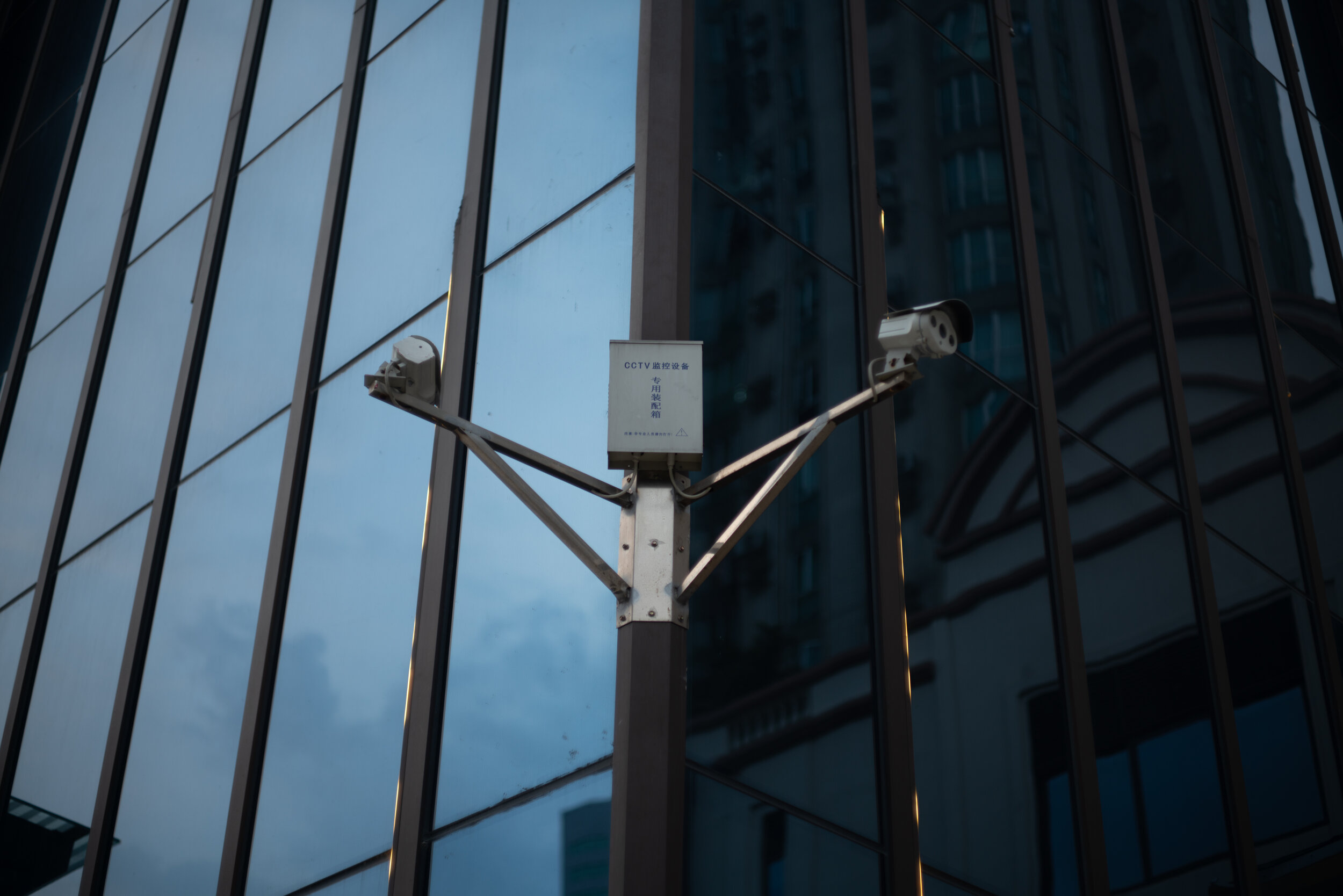

In some cases where the scene is backlit, or otherwise has high contrast, or lots of point source, you get this kind of very diffused, dreamy look.
Yea, very vintage, much old lens.
Contrast is low, and points sources overflowed to their surroundings with the help of uncontrolled spherical aberrations. Some purple (and orange) fringings are visible.

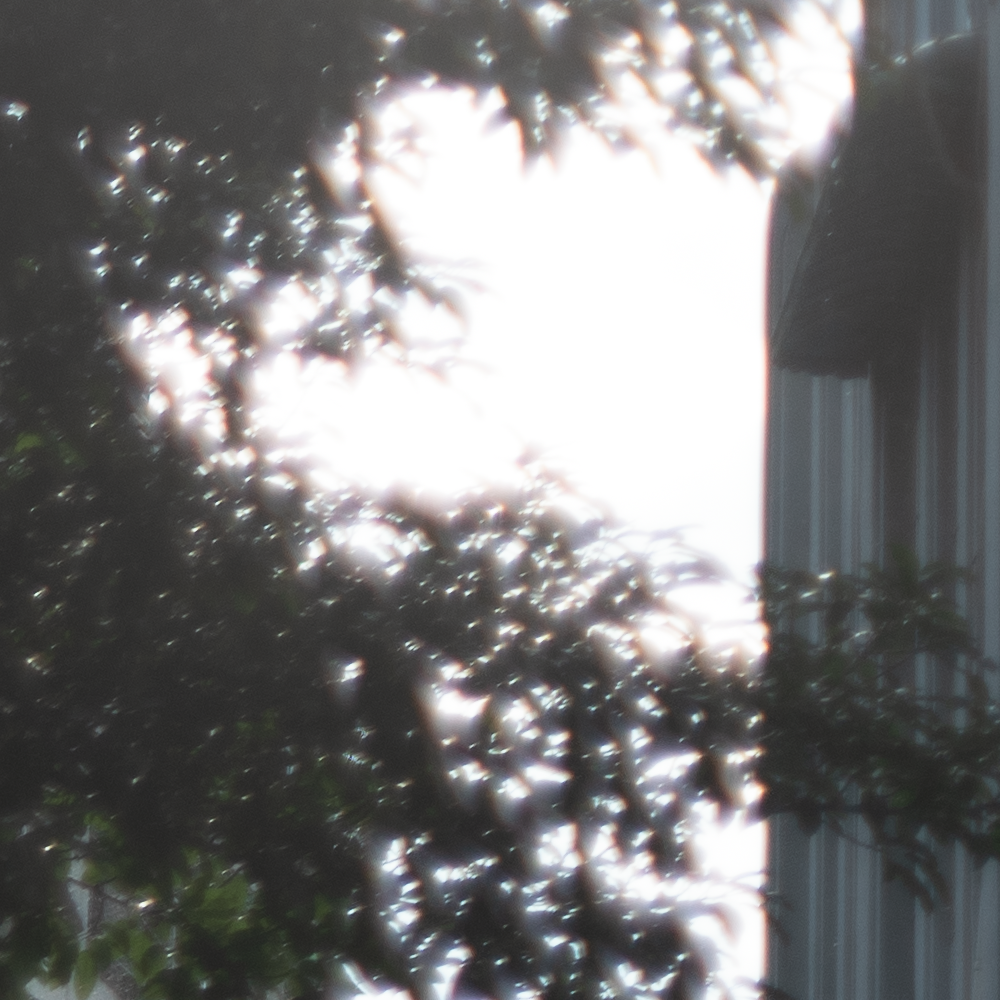
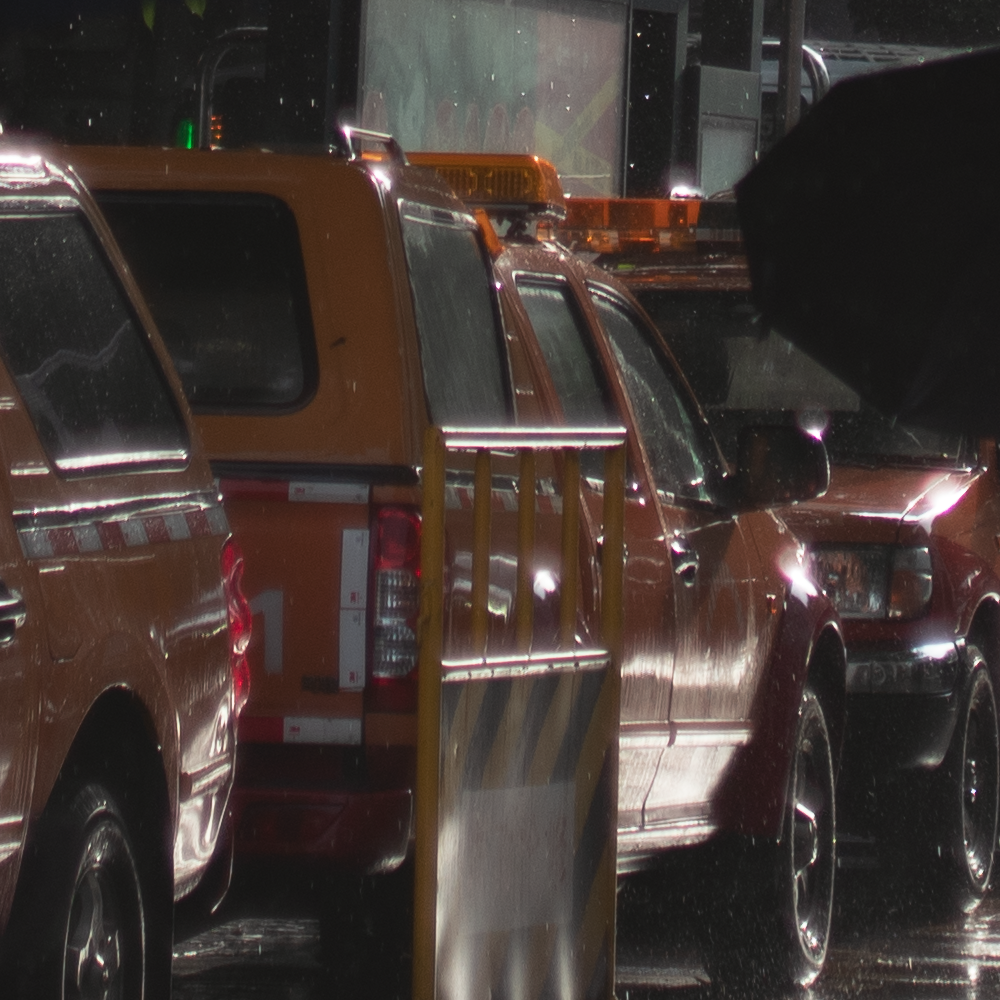
Close focus performance is what you’d expect from an all-moving focus mechanism.
SA increases significantly, with noticeable growth in field curvature. Definition is bad to nonexistent near MFD.


Chromatic Aberrations
The axial chromatic aberrations are about average in its category.
It can be easily found around edges with higher contrast and around some bokeh balls. Luckily (?), in most cases, it does get washed out by the overflowing SA at larger apertures, and it gets compensated with increased depth of field at smaller apertures.
It does exist in visible amounts. I don’t think severe enough to cause issues, in most cases.
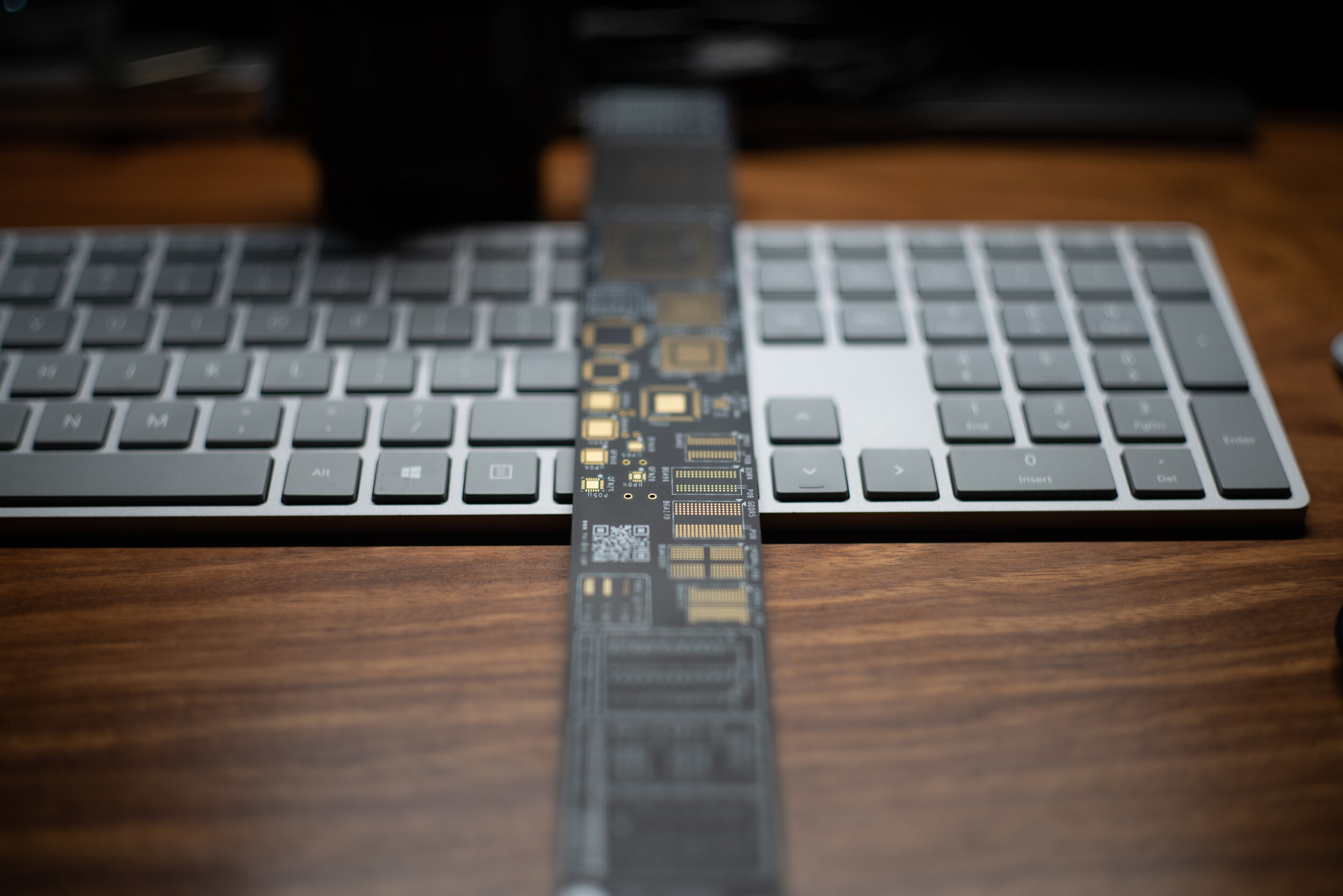
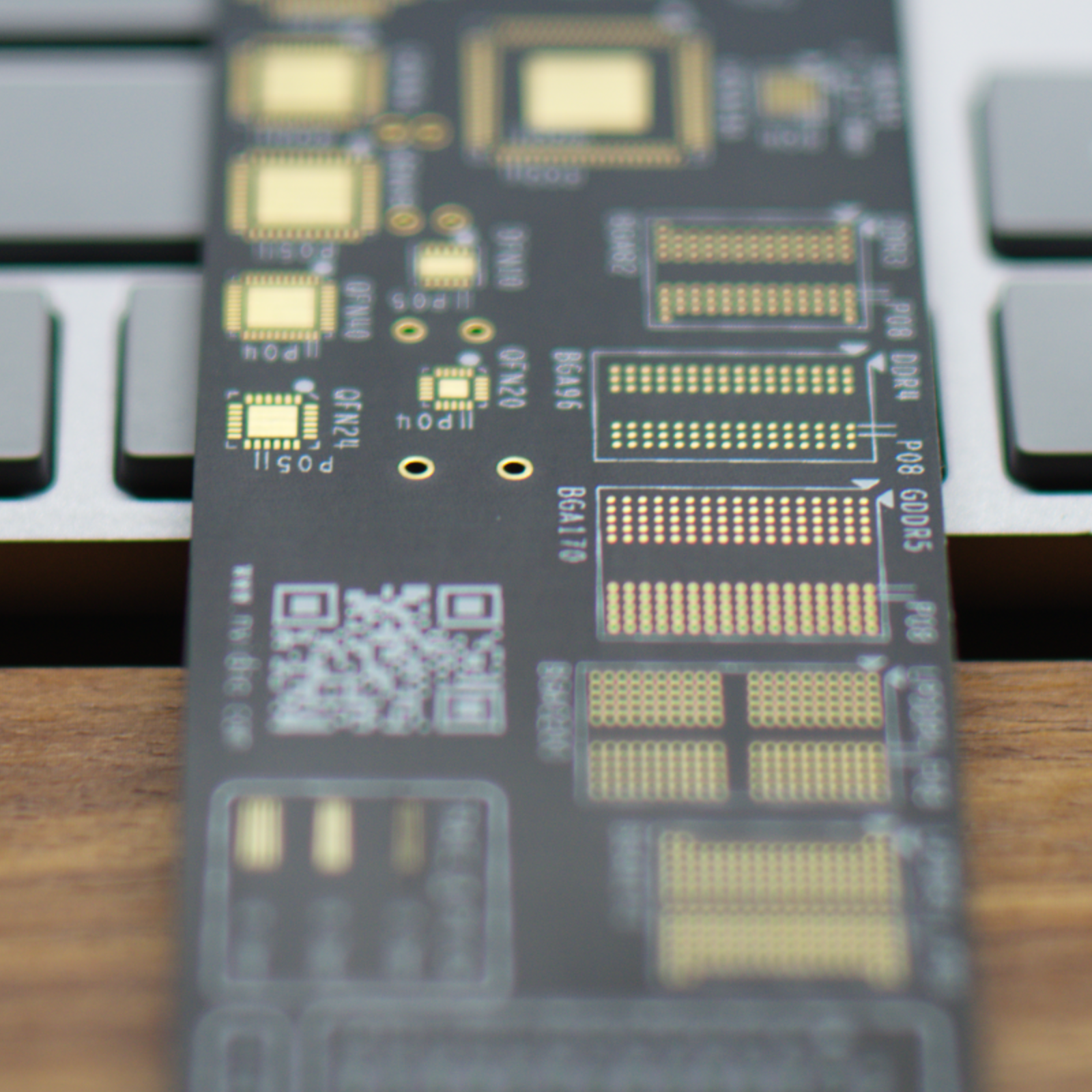


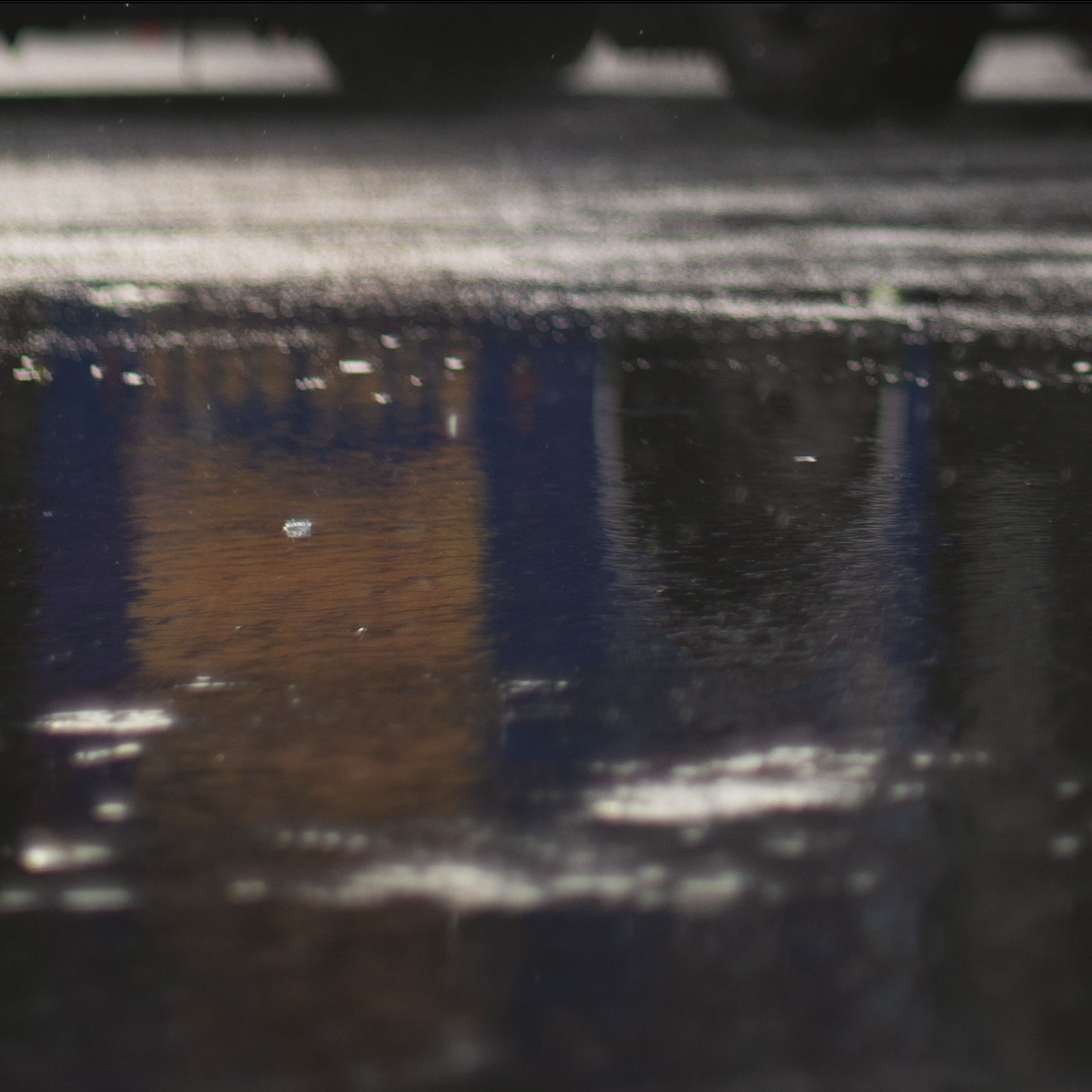

Lateral CA falls behind somewhat by modern standards, and is average performance for its time. It is visible, but not to the point where it heavily impacted resolution or hindered viewing experiences.
It reaches a greatest of 8.44μm at the far field, exactly where the field curvature and spherical aberrations are least corrected. It taper downs a bit towards the edge, but not by much.
8.44μm is not a bad score. Many modern fast primes are roughly in the same league. It’s not great, but we’ll let it pass. As it did not negatively impact resolution to any notable extent, we’ll let this one pass.
Bokeh and Color Rendition
Chromatic Reproduction
I did not find the colors to be a strength of the Ultron. We all know from the previous sections that the Ultron has used several types of glasses having questionable transmission over shorter wavelengths. But I’ve personally ran into many lenses using materials or ever poorer spectral performance, in larger quantities, and in greater thicknesses. Yet even compared to those ones, the Ultron renders its cyans, blues and purples very undersaturated.
Its blues appear to be very pale, and seems to have shifted towards a purplish hue. Veiling flares and overflowing CA would make this situation even worse, as flares are essentially colorcasts, and CA will reduce contrast and saturation near edges. But even with very flat and glare-free fields, such as the sky image below, we can clearly see the blues are underrepresented.
Reds and oranges fare much better. They do suffer somewhat from the undersaturation issue, but to a much less extent. It takes far less effort in post to bring them to that rich, warm and juicy look.



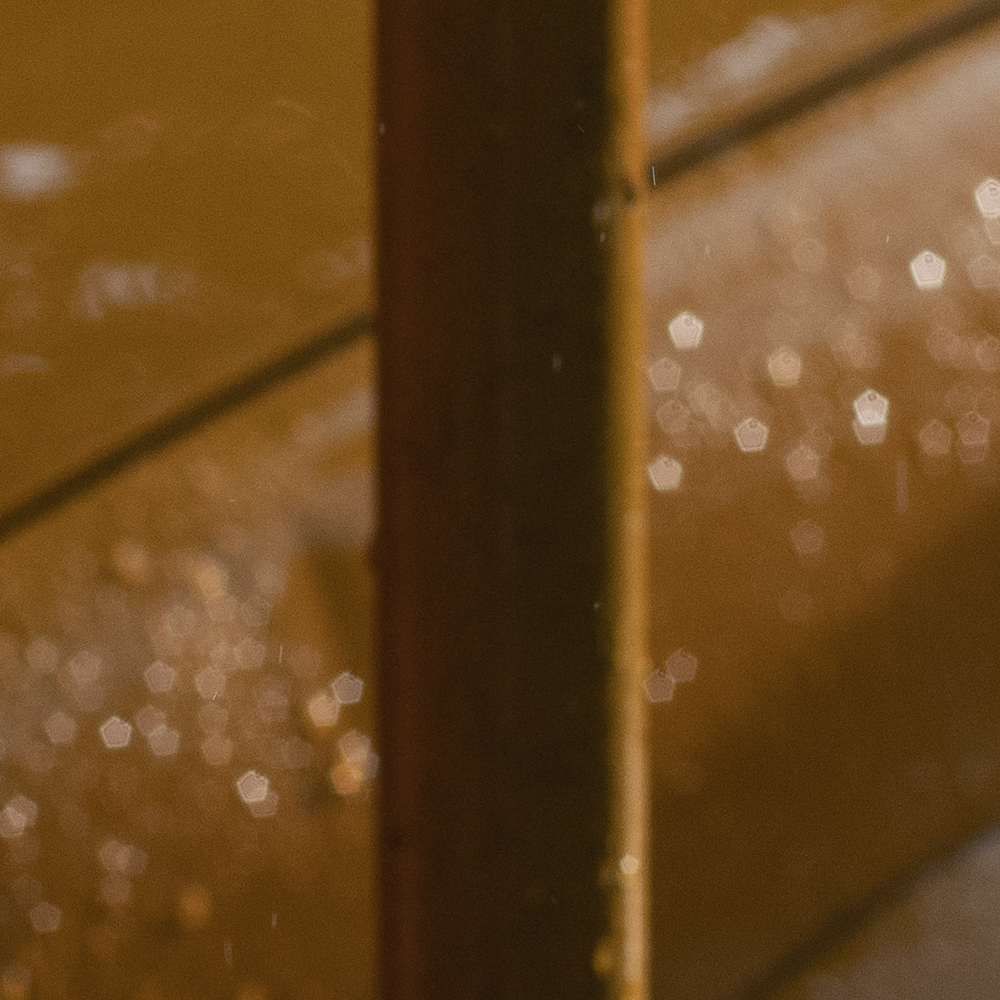
Bokeh
Bokeh here is very “vintage.”
There are strong outlining, making the out of focus image appear very harsh and nervous. It’s not that kind of defined, thin and bright outlining you can find on some specialty lenses either, such as some of the Arri DNA lenses. Subject isolation was poor. Complex backgrounds, such as buildings and trees, will be projected in various outlined strips of light.
Transition zone at all distances bodes similar character. They were pointy and nervous. I did not find myself appreciating them too much. It does improve somewhat qualitatively with stopping down, but not much.
Considering the Ultron essentially let the lower order SA go, I would consider this performance to be unreasonably undesirable. Most times residual lower order would contribute to soften the bokeh, and that either did not work here, or did not work enough.
Coma also contributed to the bokeh quality here, negatively. Near the edges, bokeh balls are stretched to a shell shape, you can probably call it almost triangular. Coma is a type of aberration caused by deformed image of the stop on the Gaussian plane. As we all know, the image of the aperture stop, is essentially what shapes the bokeh. We’ll dive deeper into coma in the later sections.





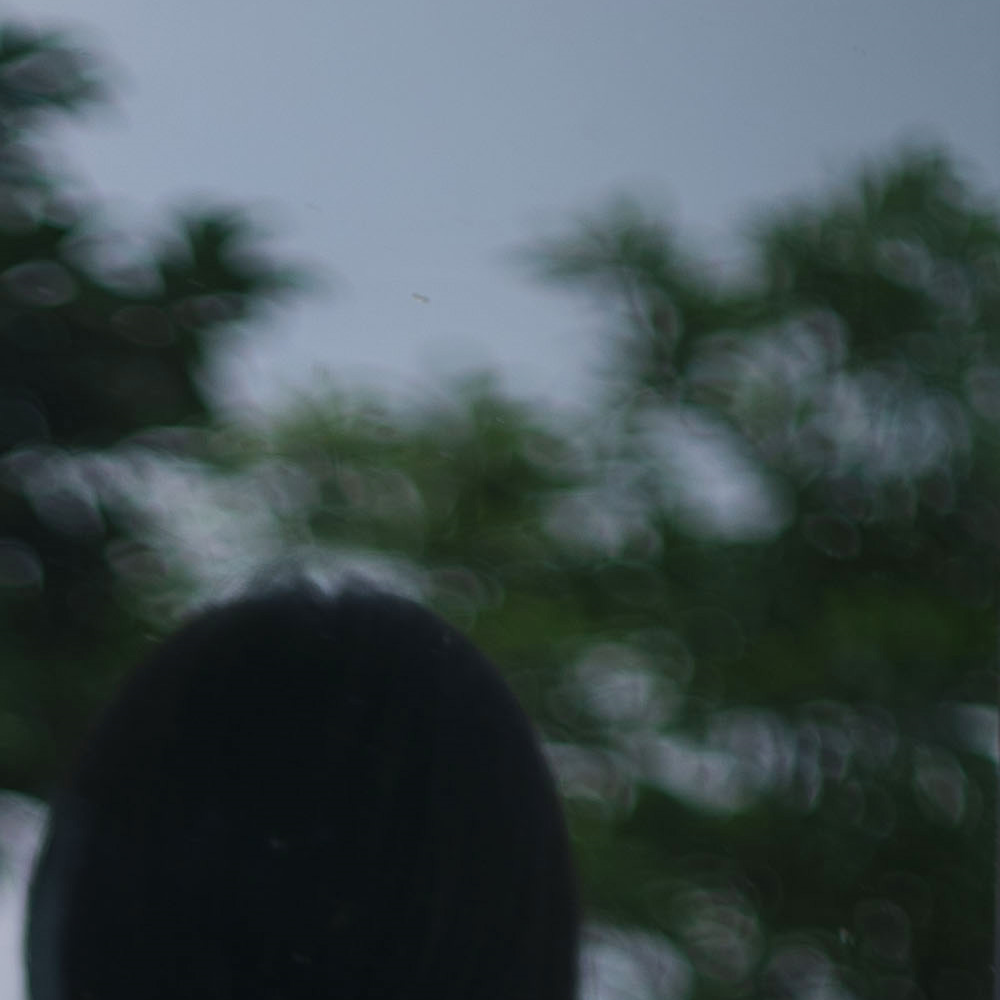



The first three images (along with their crops, so the first six) above are provided by @ayan . These images were tuned and adjusted before they were provided to me.
The five-bladed aperture will give you pentagonal bokeh when stopped down. I don’t find it to be an issue. It’s obviously not round, but it’s not obtrusive like the table saw bokeh some Leica M lenses produce.
Anyways, as far as bokeh is a subjective parameter, I’ll cease to judge his particular aspect here.
One thing though, bokeh is one of the last things that is impossible to adjust in post, unless you shoot lightfield camera or do focus stacks. You can’t even make plain bokeh into stylized ones, much unlike other qualities. Out of focus rendering by itself is a convolution process. It is impractical to deconvolve the blurred image and rebuild it to your liking. So, once the bokeh is rendered, it’s final. Make sensible decisions when choosing your lens.


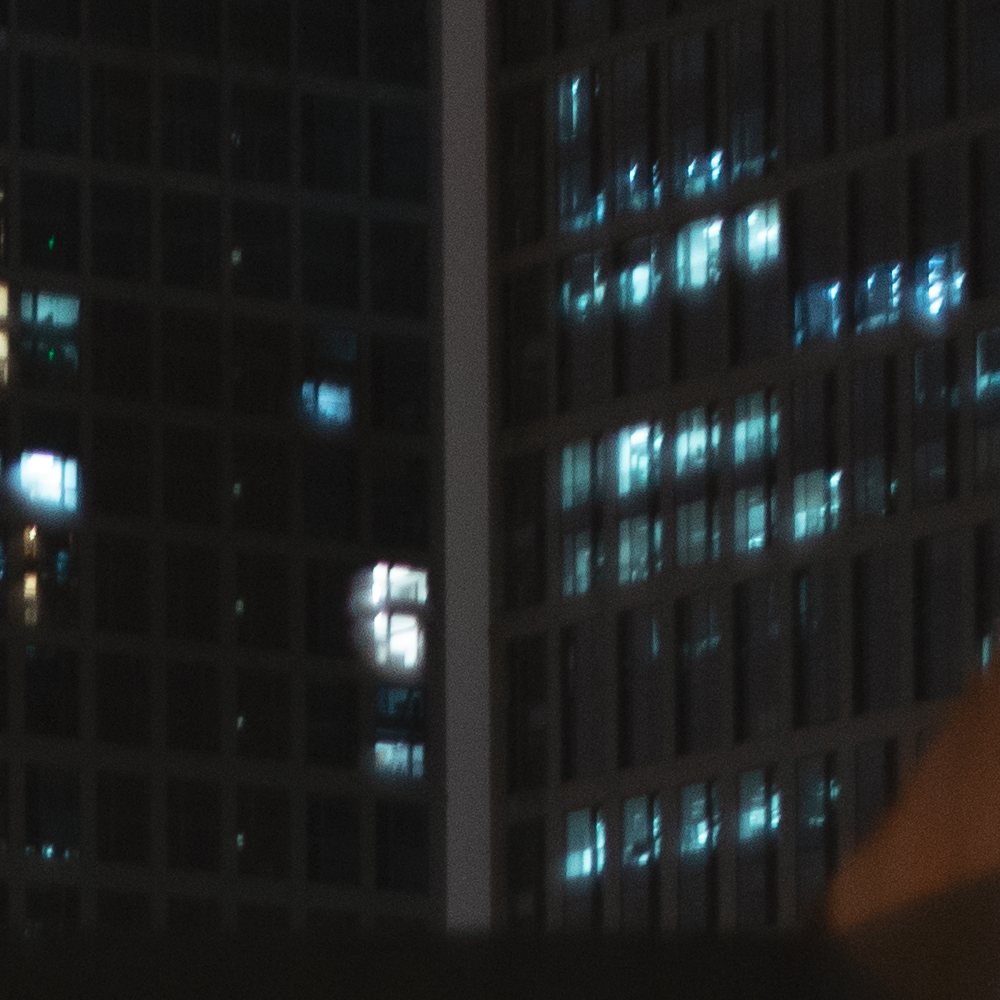
Coma and Sunstars
Coma was not a strength of the Ultron. It started to become visible near the center, with the magnitude of it increasing as we go down the field.
Tonnier said the two dispersive elements around the aperture are specifically tuned to suppress this particular aberration, I don’t see this fulfilled to the promised level. This is both an active choice and something limited by technologies. Lenses today usually use aspheres near the rear and cemented elements to retain an undeformed wavefront at terminal image. Lacking both, part of this performance is understandable. On the other hand, I would consider this is as much as an active choice with the intended correction of resolution anisotropy.
The position of the aperture stop is an usually unseen contributor to image quality. It affects field curvature, astigmatism, distortion and obviously, coma. In the particular case of coma, differences in axial position of the stop can affect its projected image on the Gaussian plane. When it does not sit in a symmetrical “natural position”, the paraxial rays, or the edges of the aperture image, will turn out to have different ray path lengths than the chief ray. This results the aperture image having different magnification at the edges than the center, and thus appears distorted or twisted. In other words, the Sine Condition is violated by moving the stop position axially. In an asymmetrical design like the Ultron and many more, the optimal stop position for correcting coma and that of astigmatism may not be the same. In this very case, the coma was clearly traded off.
Night shots containing point sources are impossible with the Ultron at settings wider than f/4.0. There are so much coma that it is even readily visible in bright daylight.
Not very good performance.
The Ultron appears to have 10-point sunstars from its pentagonal aperture. The blades of the sunstar alternate in length until about somewhere between f/4.0 and f/5.6, where finally some definition started to show. They appeared loose and not very pointy, lacking general definition.
I did not find the sunstars particularly attractive.
Flares, Transmission and Vignetting
Flare Resistance
Here we go.
The saying that ancient Sonnar lenses were extremely bright and boasted exceptionally high contrast is not just a myth.
The more glass-to-air surfaces you get, the more light rays get bounced around, causing veiling flares and ghosts. Many bounced from brighter parts to the darker parts, reducing overall definition and contrast. Sonnar structure at one branch has evolved to contain only two cemented triplets, one in front of the aperture stop and one behind. My website’s icon actually happened to be a typical cemented Sonnar triplet if you would look on the browser tabs. This kind of design effective eliminated glass-to-air surfaces, reducing which down to as little as only four. In the age where good coating was not a thing, this design produced only very minimal stray rays and flares, hence the great contrast.
In contradiction, with as much as 12 glass-to-air surfaces, the Ultron was almost destined to fail. And it did so most spectacularly.
Even judging by early 70’s standards, its flare performances aren’t great. Pentax developed their Super Multi Coatings, arguably the mother of all modern multi-coats, around the same time with the Ultron, and first lenses bearing the SMC was released in 1971. Not many years after that, other manufacturers either borrowed or developed similar technologies, such as the Canon Super Spectra Coating or the Zeiss T*, giving lenses from the mid- and late-70’s a great leap forward in flare resistance.
Unfortunately the Ultron was not one of them. Zeiss did not release a re-coated version of it before the end of its production either.
And surely by today’s standards, the Ultron’s flare resistance is a landslide, a sheer disaster. Shockingly awful.
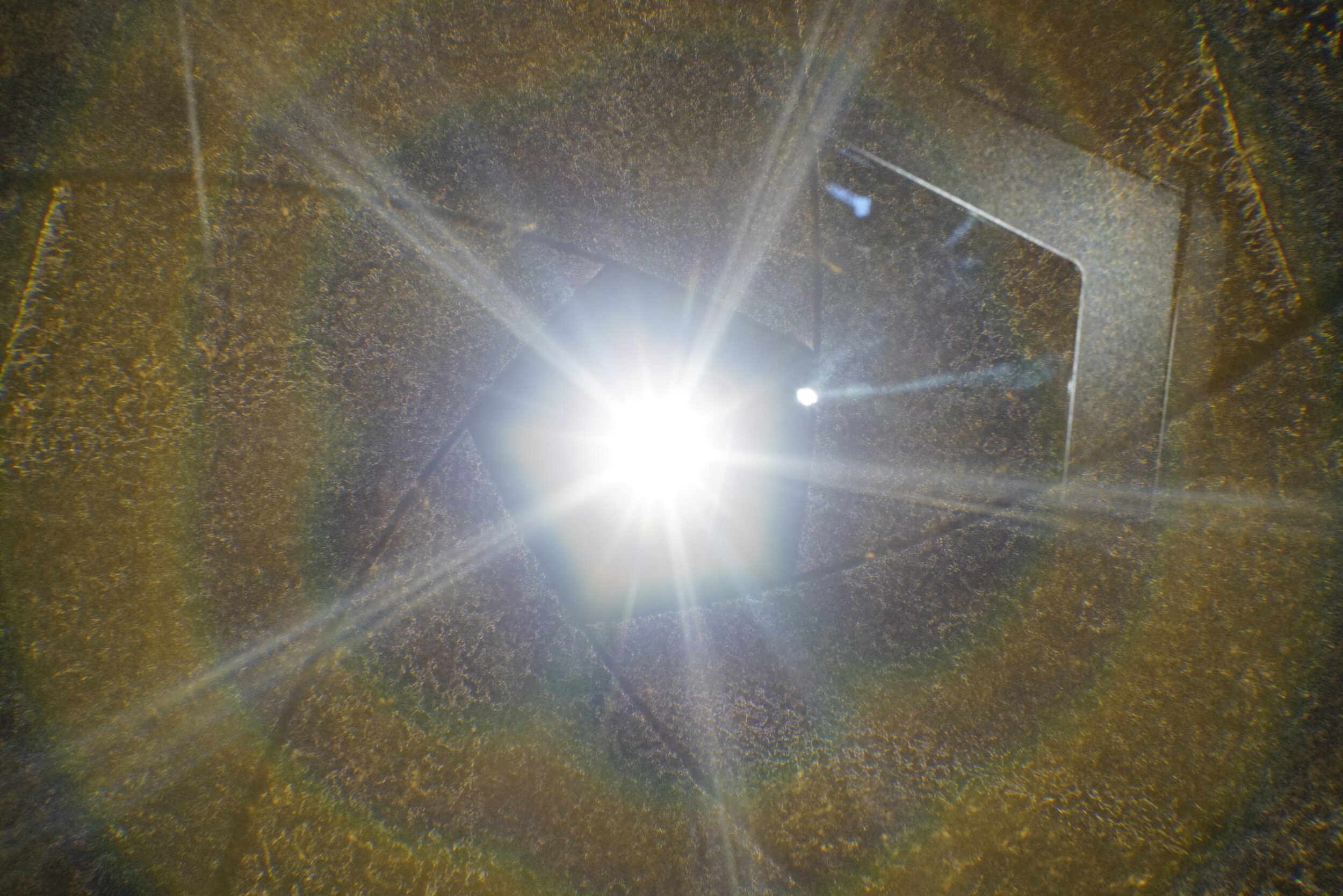
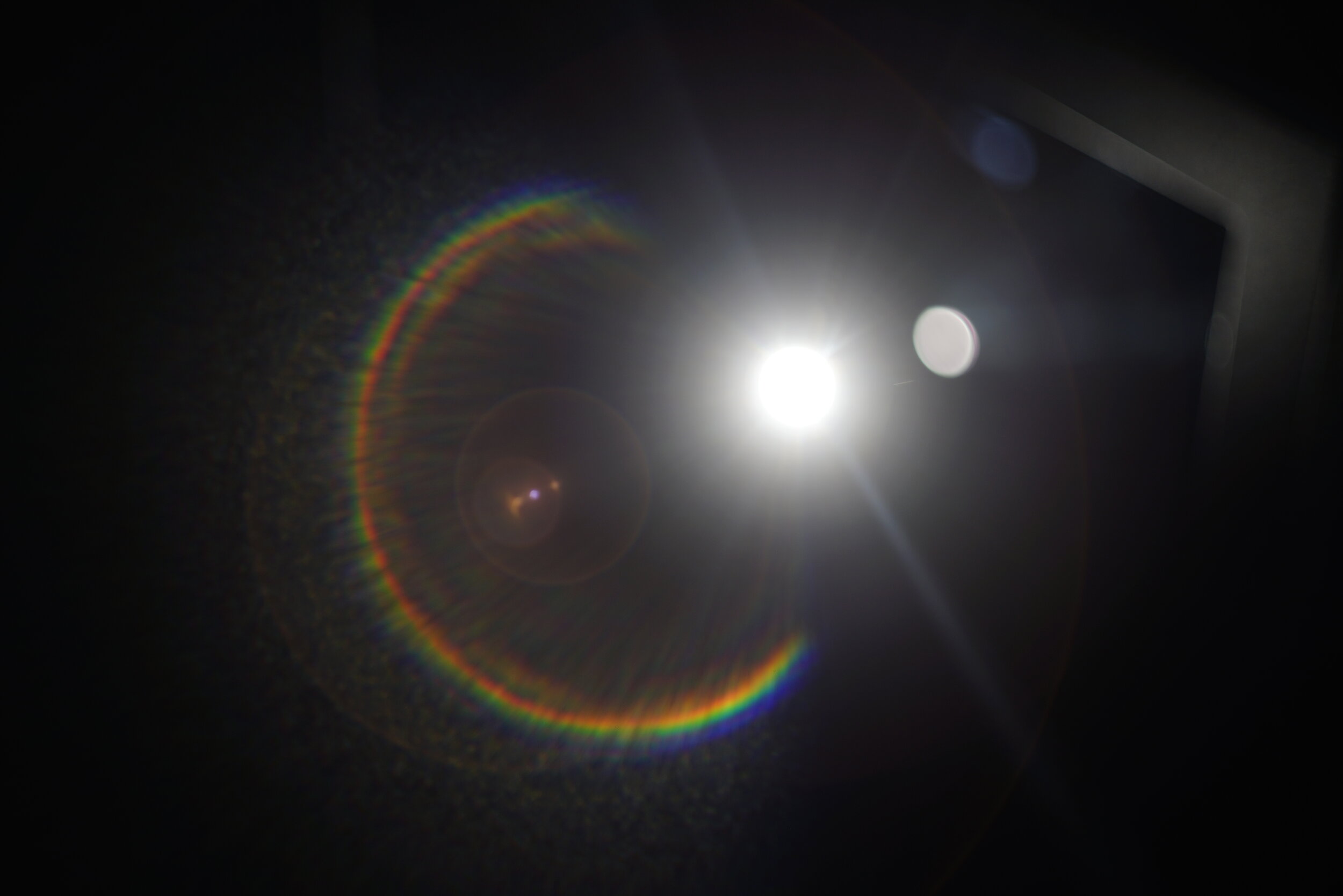
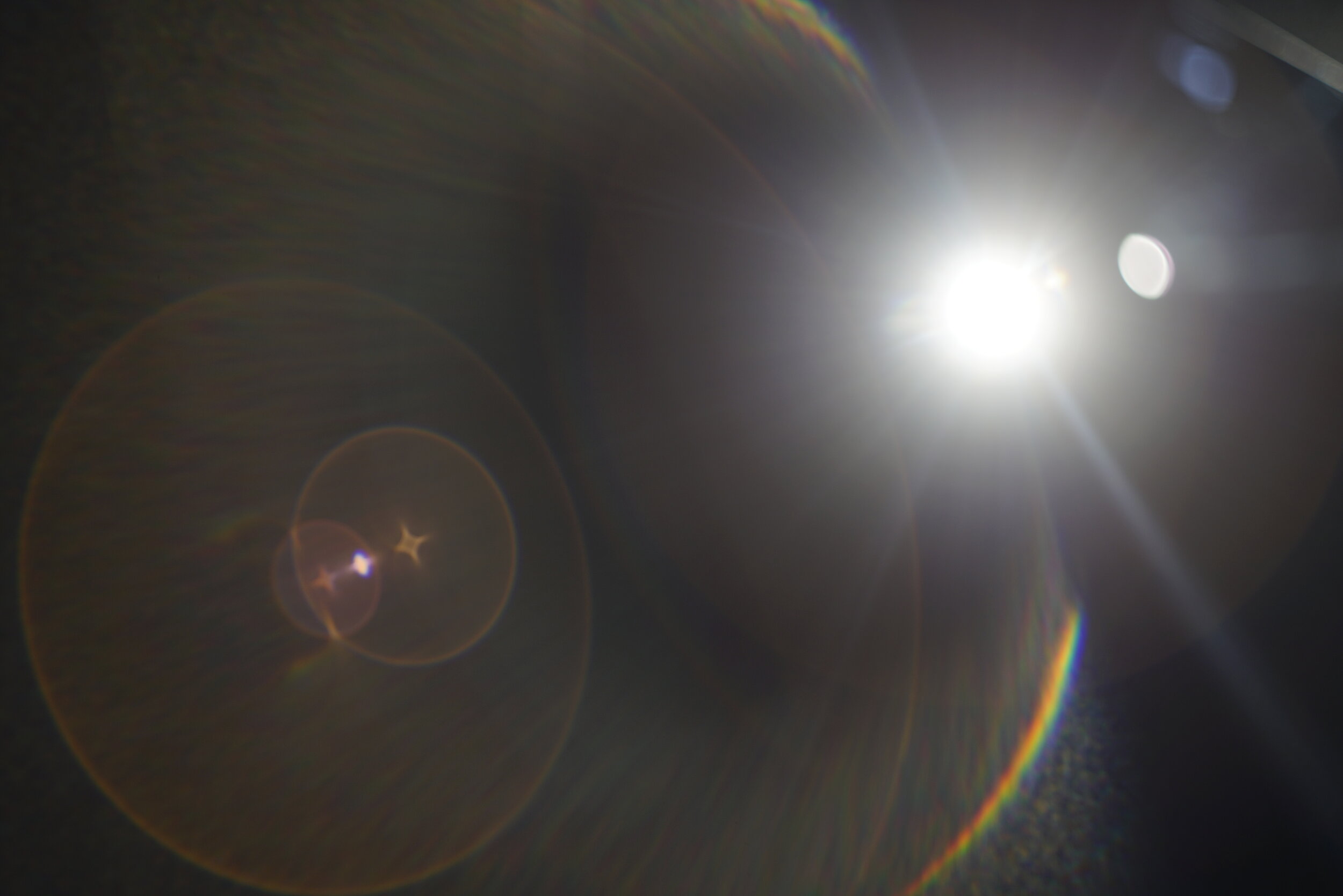
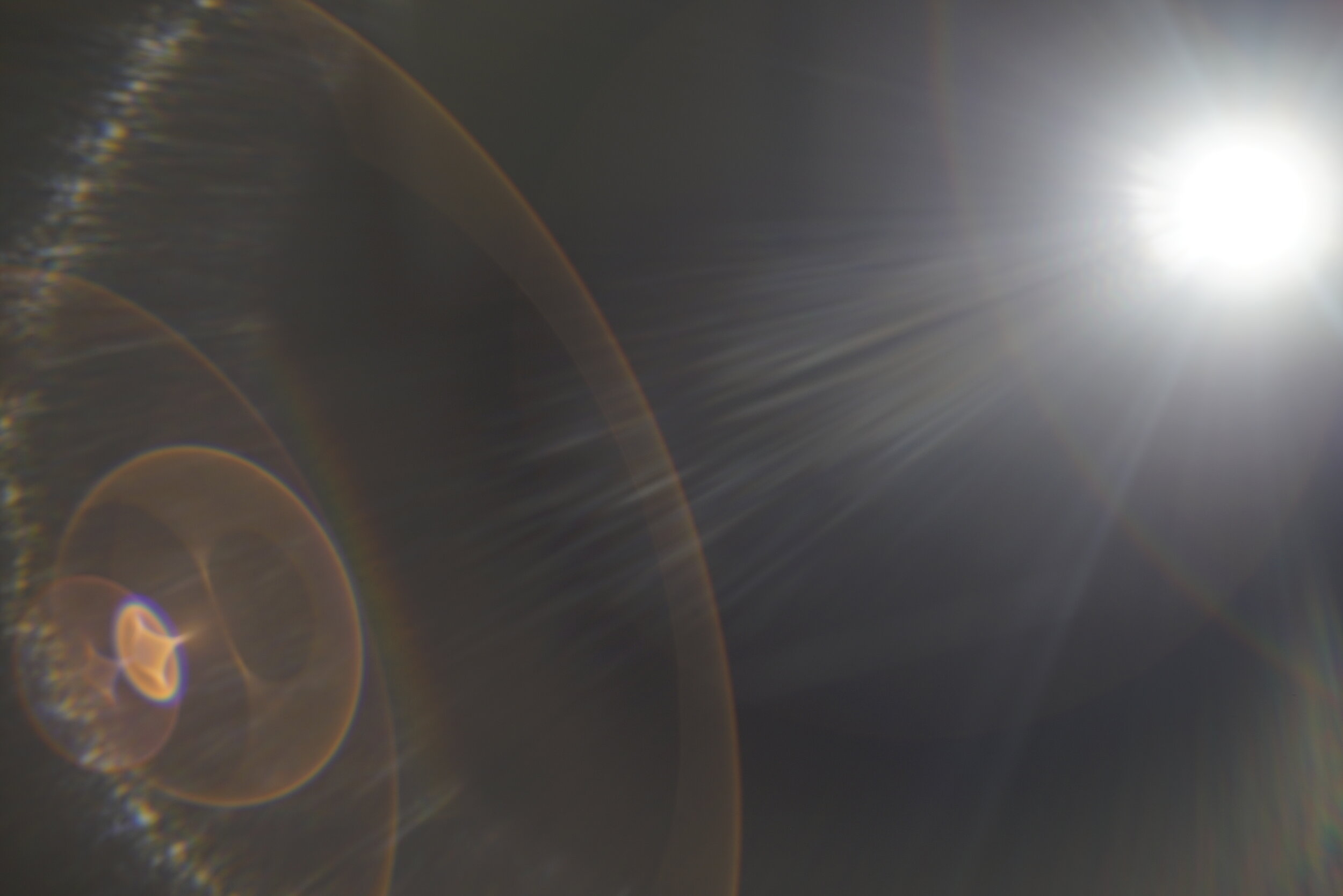
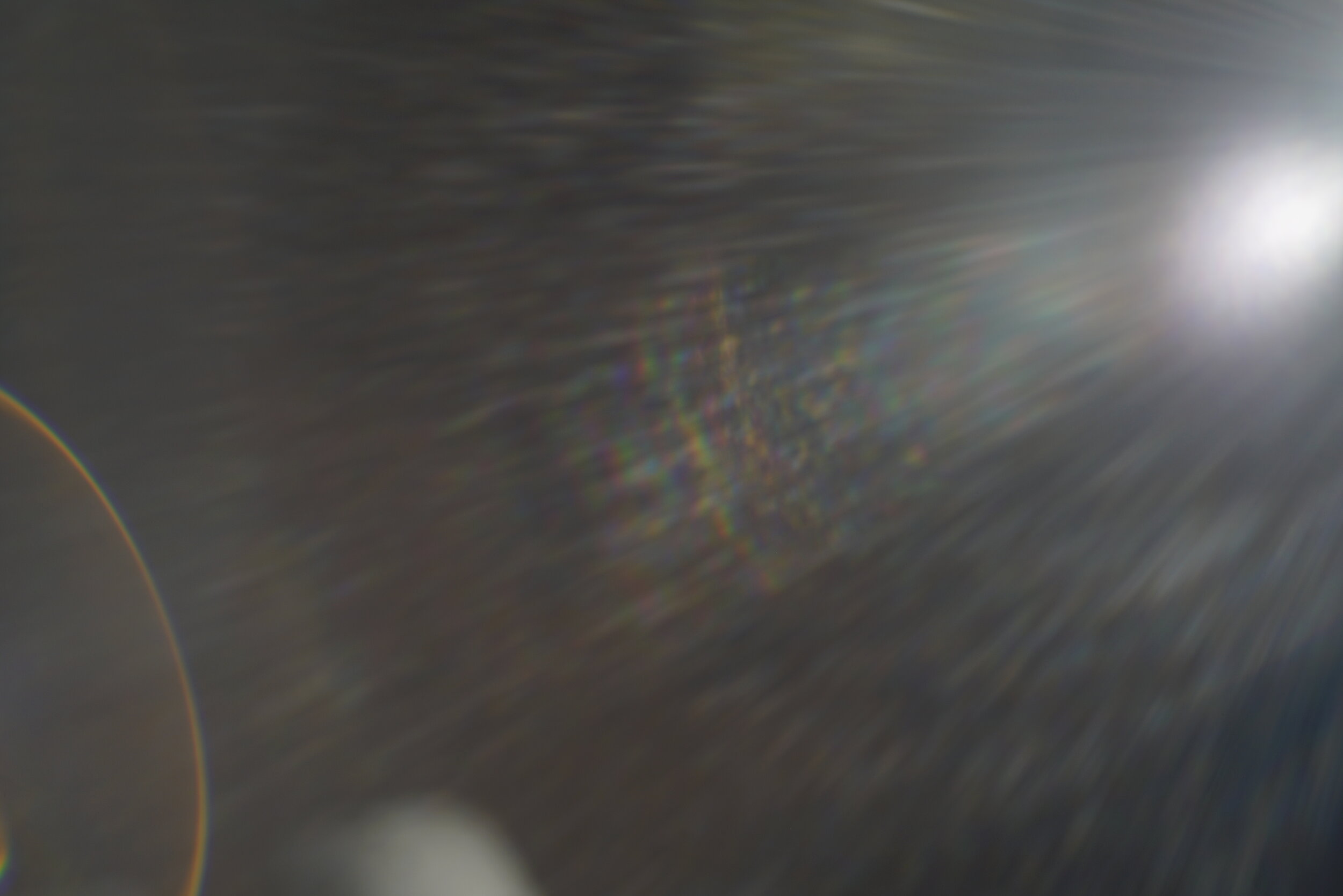
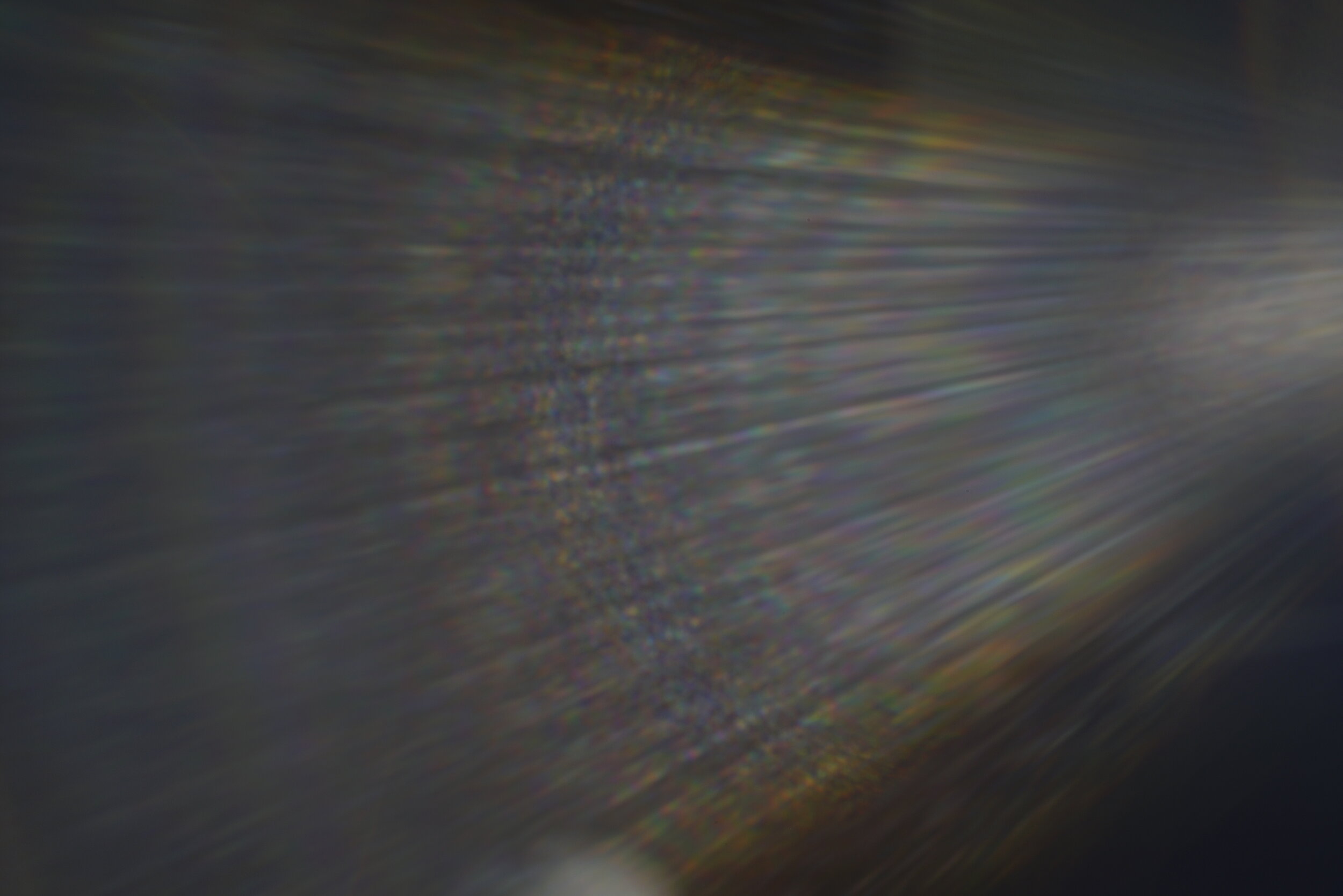
Yes. That round yellow object shown in the first picture is the reflection of the aperture blades on the glass. I’ve seen sensor glares in all shapes and forms, but aperture glares was rare.
And that wasn’t just theoretical. You can actually see the reflection of the aperture in field. If you shoot into the sun against some shades, like trees or buildings, that’s gonna come up. I assure you.
You also get a lot of veiling flare and strays when the light is outside of the frame. This is the kind of veiling flare you’d expect to see on a 500mm lens. I’ve seen reports saying Zeiss has used special light-absorbing black paint on the edges of the lens elements and the inside of the barrel. From external visual inspection, I do see some extent of the described processing going on. However, they appear gray in speculation, and did not appear to work very well either. I do not know whether if they weren’t as effective in the beginning or if they have degraded over time.
Covering the lens with a hood or hands will help the veiling flare somewhat. There’s just too much of it that anything you do will improve the situation.
This kind of performance undoubtedly will make a lifetime remembrance.
Combined Transmission
The transmission figures of the Ultron is:
T/2.31
at the image center, wide open.
This is for sure heavily contributed by the lackluster (actually, very full of luster) coatings. Incident rays will bounces around in the lens barrel, and many were either absorbed or reflected back away. Assuming there is no errors or inflations in the marked specs, this is a 0.4EV setback.
-0.4EV from the mark is definitely going to impact the shooting experience. It may be a non-issue with TTL metering and WYSIWYG viewfinding on modern cameras, but that is going to be a problem for certain film bodies. Users should take this into account when exposing manually. This transmission dip is also going to be an issue in poorly illuminated scenes, affecting both digital and film alike.
Illumination Falloff
Averaged vignetting of all four corners is -2.38EV.
Let me give you an idea of how much that is. The Canon EF 50mm f/1.2L USM, being literally an entire stop faster, were found to be at -2.35EV, a hair less vignetting when opening wide. Many more lenses faster than the Ultron have fared better in this category.
If we go back to the first section of this review, we can see the peripheral rays were cut-off by the first element. If the L1 lens were to be a few millimeters widers, this figure might have been relieved.
Unlike many other parameters, illumination falloff is not something that gets fixed with modern technologies. It bodes only to field of view and shading of the entrance/exit pupil near edges. Both are simple geometry, anyone who have been through high school physics can calculate this figure by hand. I have all the reasons to believe Tonnier must have taken this subject into account when building this lens, but to the exact reason he chose to do so remained unknown to us.
This may be due to manufacturing restrictions, as parallel aplanatic lenses like L1 is very difficult shape and polish, even today; it could also be an active effort to block paraxial rays near the edges to reduce spherical aberration and coma-forming rays. I could forgive the Ultron if it were for the first reason, but if it were for the latter, I would not think this has worked well.
My particular copy’s tilted field is also evident here. The true center (yellow circle) deviates from the geometrical image center (red square) slightly. This much error is relatively commonplace, and is not something I would worry about.
Distortion
Distortion is visible. The distortion profile is complex and far from uniform. This is another consequence of tweaking the projected image of the stop to improved astigmatism performances. Shifting the stop affects the magnification of it on different part of the frame, thus causing distortion.
From what I could observe, it seemed that there is a slight amount of pincushion distortion near the center and midframe. As you go down the field, it quickly becomes barrel, and it continues to worsen speedily towards the edges.
Obviously there is no provided correction profile included with Lightroom, Camera Raw or Capture One for a lens this old. Simple manual correction does not help with complex issues like this. You sure can use custom profile builder to create a matching correction, but I doubt that’s within the interest of most owners.
Portrait and most everyday life settings remains unaffected as long as you don’t examine every single straight line present in the image. Architectural, cityscapes and sometimes even street photography takes harm from this distortion. I would not recommend this lens for such purposes unless a custom profile is present.
Final Words
The Ultron 1,8/50 is a fine lens, perhaps even groundbreaking for its time. A few aspects of it still holds up to modern examinations, but many others don’t.
The design was undoubtedly clever. It stretched a small budget over some really great resolution performances, surpassing most 7-element Planar designs by great amounts, with a mere addition of a concave aplanatic lens in the front. At the age where design and manufacturing resources were limited, we saw many spectacular designs using and reusing available parts to their most extreme performances. That was not just optics, similar stories went on in the aerospace, automotives and electronic industries.
However much you stretch it, budgets will drain. Extreme performances are not without tradeoffs one way or another. Ignoring a number of issues limited by the technical capabilities then, it failed in terms of color reproduction, bokeh rendering, coma and distortion control, all are sacrificed just for results over a single aspect.
Even field curvature was used to compensate for astigmatism, which left a great crater in the resolution charts. So, in reality, little was won.
Engineering, optical or else, is a highly integrated, complex systematic field to tackle. The key to all is about balancing. Dancing with chains, acrobatic on thin ice, they say. Stretching all the available budget over a single parameter and sacrificing the rest, is not practical, or useful.
It’s like in school. Acing a single test and bomb the rest, you will fail miserably on that subject.
It is true that many lenses coming after the Ultron did not have such tenacious control over astigmatism or high-frequency fidelities, but they do boast much more balanced profile.
They have significantly better chromatic reproduction, field curvature correction, and distortion control. Many of them either have much smoother bokeh, or it was refined with more defined special traits that some people call “character.”
There is no such thing as “lost qualities.” Or at least so with the case of Ultron 1,8/50. Even on its home field, resolution and astigmatism, the very sport it was built for, it was easily exceeded by modern high-end lenses. As a matter of fact, the best of our optics, the flagship of every brand, be it the Zeiss Otus, the C/V Apo-Lanthar lenses, or the majority of the L series and the G Master primes, has placed unprecedented emphasis on astigmatism control. This is even more evident on the best cine prime series, such as the Summilux-C, Master Prime, and Signature Prime. And they did not have to do so at the cost of field curvature and other qualities. They are good in resolution. They are good in every aspect.
People tend to project their nostalgic feelings of their “good ol’ days” on to things like lenses. People may lie. I may lie. Data doesn’t.
Mankind continues to advance its technologies over time. It might had been inchworm movement, it might even recede on a small chronic scale, but it does build up across decades. History may be cyclical sometimes, but over a larger period, on the same vertical segment, it is very rare for old-timers to excel over recent versions on every single parameter. I’d almost claim, using any old technology, Ultron or else, to deny their modern counterparts of the same caliber, is really a denial of all the technological advancements to date.
So let the history be a part of the history.
It is a special and spectacular little old lens. The Ultron has fulfilled its job at its historical position with glory. However, forcing modern attributes on it, trying to make it stay relevant to date, or even make it compare with the latest optics is an unfit and unfair thing to do. That is not where it belongs.
If you own it, great, use it like any other vintage lenses. It is not more special than the rest. Just let it stay there, the place it truly belongs.
Dust to dust, if that’s how you’d like to call the process.
The following gallery contained select sample images tuned to taste. Sharpening, etc., were applied when necessary.
These images, along with their corresponding originals, are available on OneDrive.



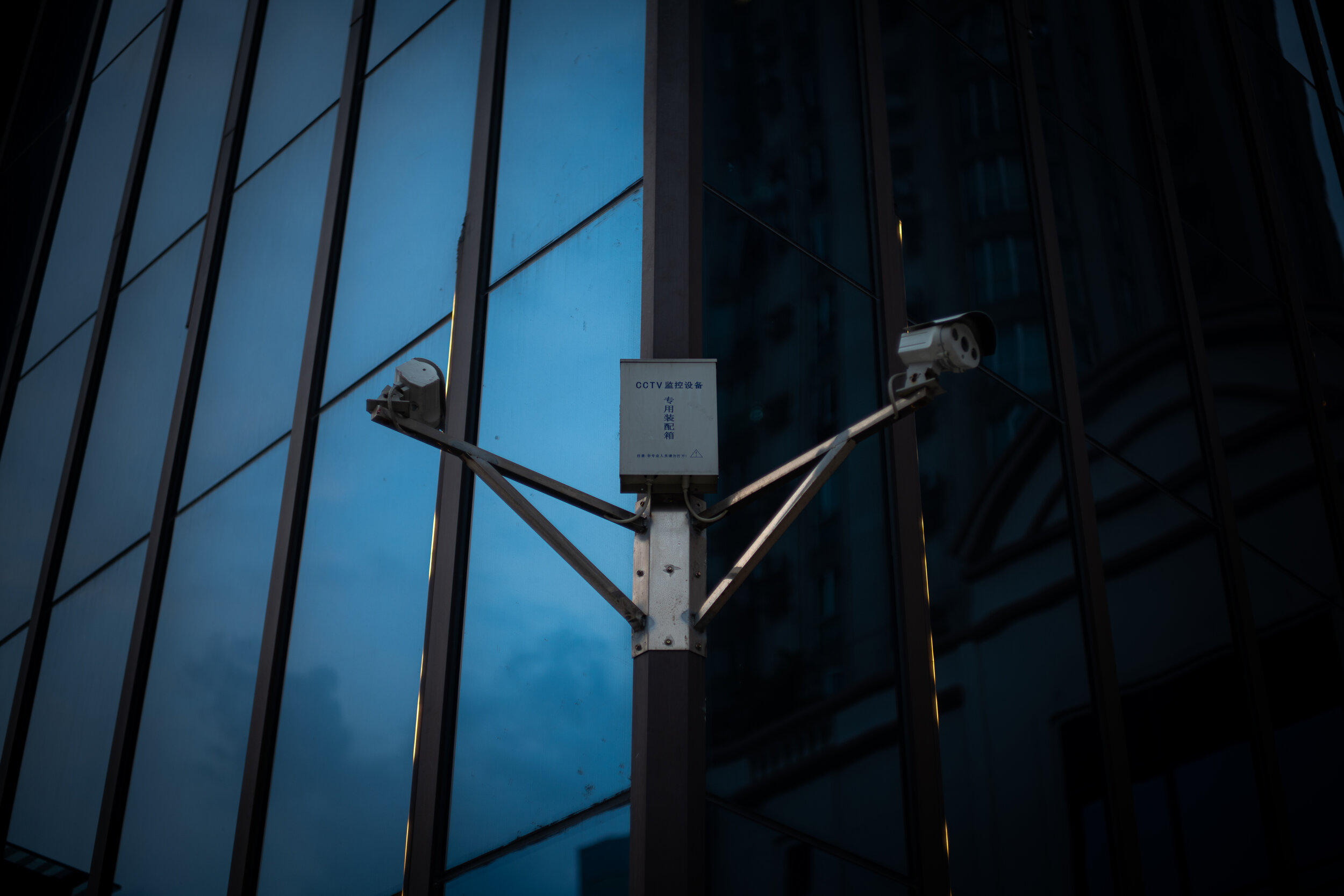

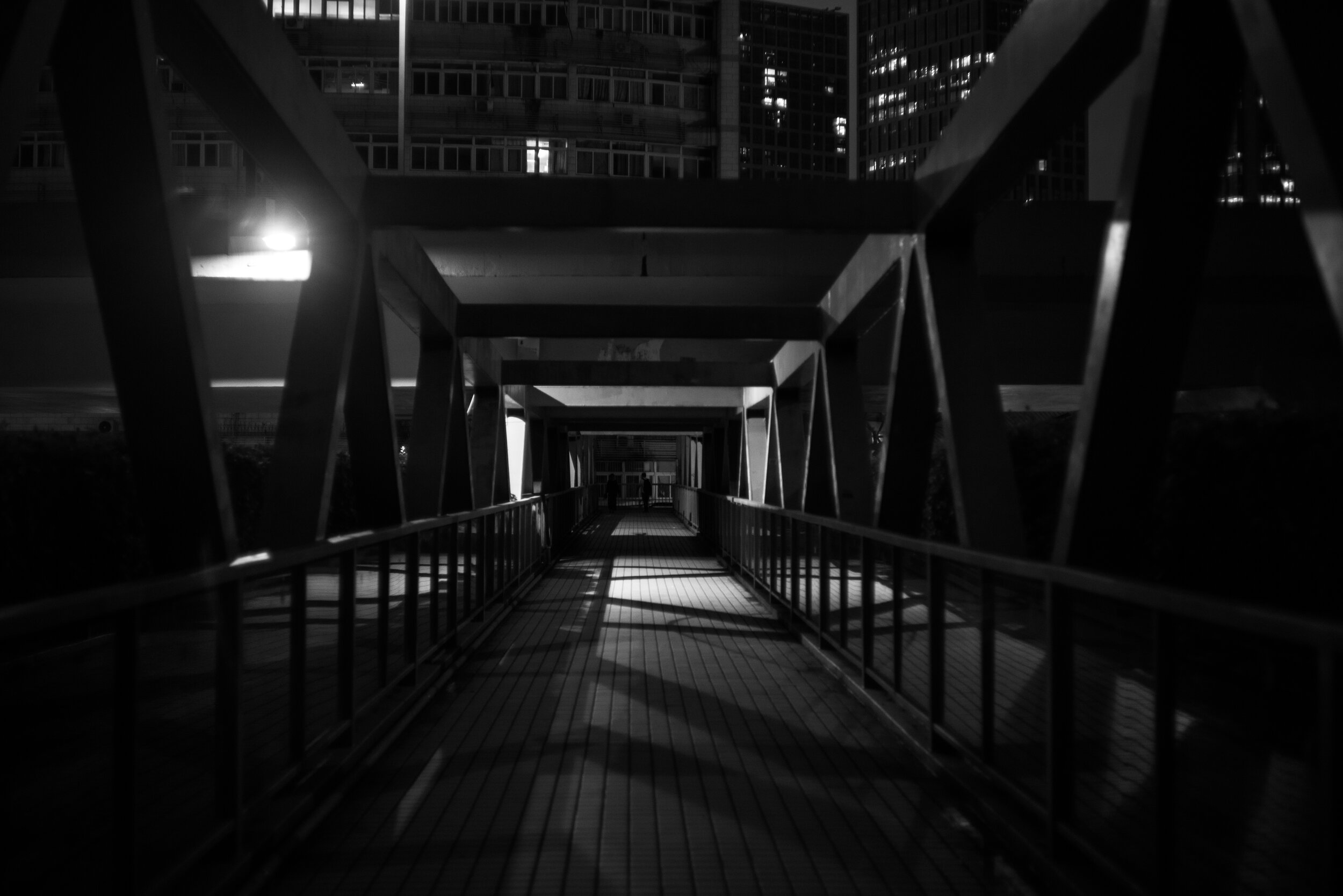
I would not provide purchase consultation or alternative recommendations in this article.
Those people who's going to buy the Ultron already knows, and I don’t believe this article is enough to transform those modern-optic lovers.
WARNING: as the Ultron 1,8/50 is a piece of vintage optic, it is highly likely that many were disassembled and reassembled for cleaning, repairs or other purposes. These processes will significantly increase copy-to-copy variation and would likely reduce optical quality of the units subjected to the operations. This test does NOT represent all Ultron units, and DO be careful buying should you choose to do so.
Copyright © Wavechaser 2019-2020





